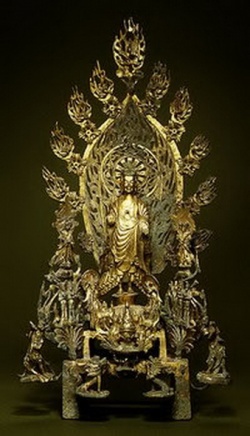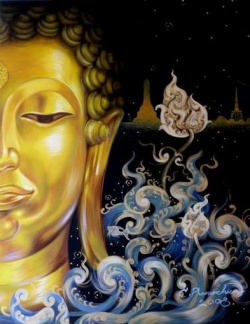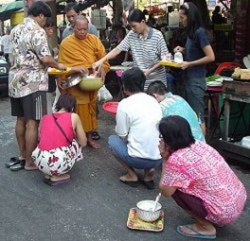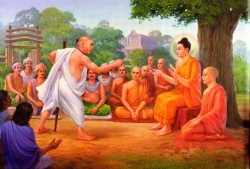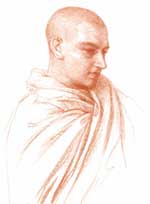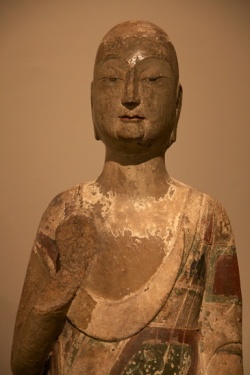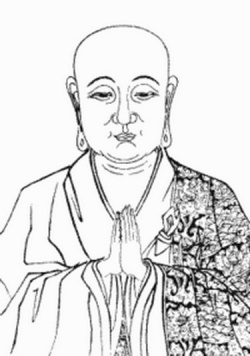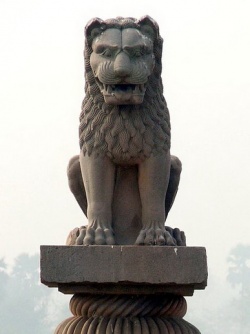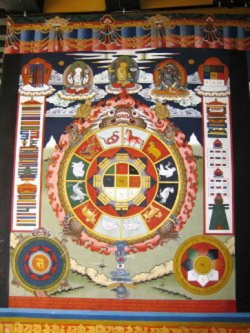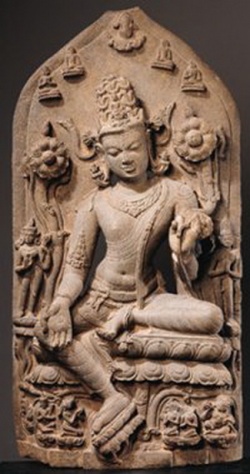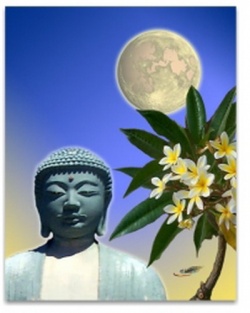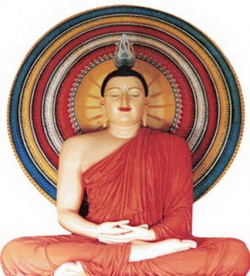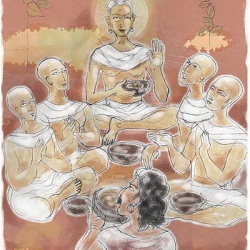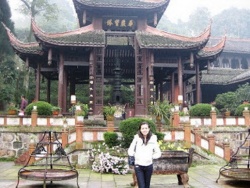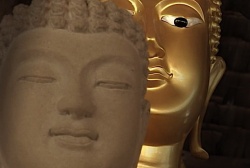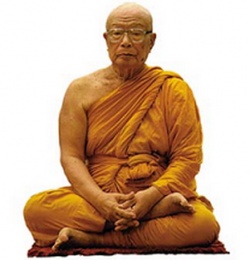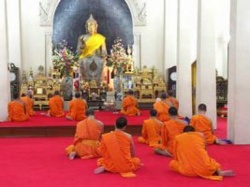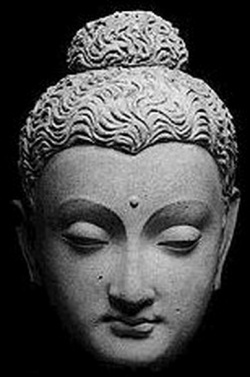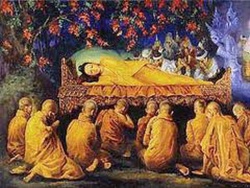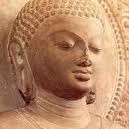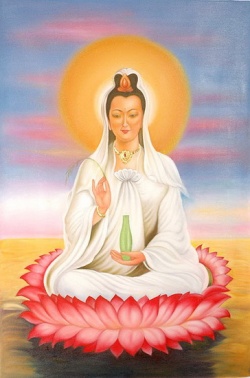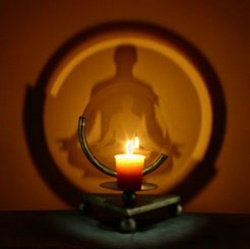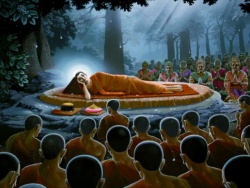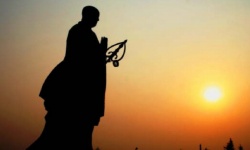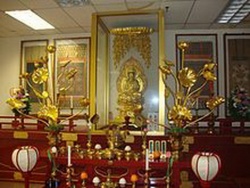Buddhism in Sri Lanka by H.R. Perera
1. State of Sri Lanka before the Introduction of Buddhism
Buddhism was introduced to Sri Lanka in 236 b.e. (cir. 250 BCE)[1] and became the national religion of the Sinhalese from that date. It is, however, necessary for a proper study of the history of Buddhism in the island to consider the state of the island and its social and political developments and the culture and character of the people immediately preceding this period. This will enable us to get a clear understanding of the manner in which such a far-reaching revolution in the beliefs, manners, customs and character of a people was effected by the introduction of this new religion and the progress in literature, art and culture that has been manifested through its influence.
2. Early Traditions
According to the early chronicles relating the historical traditions of Sri Lanka, a prince named Vijaya and his followers who came from India and landed in Lanka on the day of the Parinibbaana of the Buddha were the first human inhabitants of this island. When they came the island was occupied by "yakkhas" (sprites, demons). "Yakkhas" and "naagas" are also said to have inhabited Lanka in the time of the Buddha. A legend relating the existence of a great civilization before this time, under a king named Raavana, is also current though the early chronicles make no mention of it.
The Vijaya legend of these chronicles is taken by modern historians as a poetic expression of the actual aryanization of Sri Lanka in about the sixth century BCE The term "yakkhas and naagas" may refer to the aborigines who occupied the island before their arrival. No traces of an advanced civilization, however, have yet been discovered to support the Raavana legend. Archaeologists have discovered chert and quartz implements and tools at various sites, believed to have been used by aborigines of Sri Lanka, and they indicate that these people were a primitive tribe who lived by hunting. These aborigines have not left traces of a strong political organization or an advanced culture. The present Veddas are believed to be their descendants.
3. Colonization by Prince Vijaya and his Followers
Vijaya and his 700 followers are described in the Lankan chronicles as a set of adventurous young men who, when they were banished from their Indian homeland Laala (or Laata), came in search of new land for settlement. Other legends, some of which are even older, relating how the first aryan inhabitants came to settle down in Lanka are found in several Pali and Sanskrit works. Most of them show that the settlement of early aryan settlers is due to the enterprise of the pioneering merchant mariners who came to this island for pearls and precious stones. Historians thus do not lay much reliance on the details of the Vijayan legend but they accept Vijaya as the first traditional ruler of the newcomers — the Sinhalese.
Vijaya, who was a Kshatriya,[2] landed in Lanka, according to the chronicles, on the day of the Parinibbaana of the Buddha. He allied himself with an aboriginal princess named Kuveni and married her and with her influence soon became the master of the country. Later he drove Kuveni away and obtained a princess from Maduraa whom he made his queen. Maidens of high birth came from the Pandyan kingdom as wives of his followers.
Vijaya ruled from his settlement Tambappanni and his ministers founded other settlements like Anuraadhagaama, Upatissagaama, Ujjeni, Uruvelaa and Vijitapura. Thus the earliest settlements that were founded in the time of King Vijaya were located along the river banks in the northwestern region of Lanka like the Malvatu-oya and the Kalaa-oya.
4. Political Development and Social Organization after Vijaya
Vijaya died after a rule of 38 years. Since he had no son to succeed him, before his death he sent messengers to his brother Sumitta in Sihapura to come and rule here. Sumitta sent his youngest son Panduvaasudeva, since he himself was king of Sihapura and was also too old. Panduvaasudeva, Vijaya's nephew, arrived one year after Vijaya's death during which period the ministers of Vijaya ruled the country. When Panduvaasudeva came he brought with him 32 sons of ministers.
The early chronicles preserve an episode which connects the Sakka family of the Buddha with the sovereignty of Lanka from the time of King Panduvaasudeva. According to this account, Bhaddakaccaanaa, who also arrived in Lanka with 32 other maidens shortly after Panduvaasudeva arrived, was the daughter of Pandu Sakka, who himself was the son of Amitodana, an uncle of the Buddha.
Panduvaasudeva ruled for 30 years and was succeeded by his eldest son Abhaya, who ruled for 20 years. Abhaya's successor was Pandukaabhaya, the son of his sister Ummaadacitta. Pandukaabhaya was a great ruler in whose reign Anuraadhapura developed into a great city with well-marked boundaries. After a long reign of 70 years, Pandukaabhaya was succeeded by his son Mutasiva who ruled for 60 years. Mutasiva's second son, Devaanampiya Tissa, succeeded him in 250 BCE, that is, 236 years after the accession of Vijaya.
These 236 years could be reckoned as a separate period in the history of Sri Lanka for it formed the background for the offical introduction of Buddhism, which occurred during the opening years of the next ruler, King Devaanampiya Tissa. During this period the aryan colonists founded settlements along the fertile river banks almost throughout the island. They chose the river banks because they were mainly agriculturists. Thus the regions watered by the Malvatu-oya, Kalaa-oya, Valave-ganga, Kirindi-oya, Menik-ganga and Kumbukkan-oya, the Kelani-ganga and some regions around the Mahaveli-ganga soon became populated. Anuraadhapura became a well-organized city with boundaries marked, lakes dug and hospitals and other buildings constructed.[3] In the south, Mahaagaama (Maagama), became the center of activity. The majority of the aboriginal inhabitants were absorbed into the new community through intermarriage while a few withdrew to the Malayadesa, the highlands.
5. Pre-Buddhist Religion in Sri Lanka
It is evident from the chronicles relating the early history of Sri Lanka that before the introduction of Buddhism in the reign of King Devaanampiya Tissa (250-210 BCE) there was no single religion which was widely accepted as the national religion of the country. Nevertheless, there was a wide range of religious beliefs and practices, different from one another, and each individual seems to have freely observed his religion according to his belief.
A noteworthy feature of the pre-Buddhist religion of Sri Lanka is that it was a mixture of the aboriginal cults and the beliefs of the aryan newcomers.
The worship of yaksas and yaksinis was a widely prevalent aboriginal custom of pre-Buddhist Lanka. King Pandukaabhaya, the grandfather of Devaanampiya Tissa, provided shrines for many of these spirits and also gave them sacrificial offerings annually. Some of these yaksas and yaksinis mentioned by name are Kaalavela, Cittaraaja, Vessavana, Valavaamukhi and Cittaa. Vyaadhadeva, Kammaaradeva and Pacchimaraajini, though not known as yaksas and yaksinis, also belong to the same category of aboriginal spirits. Trees like the banyan and palmyrah were also connected with the cults of these spirits showing that tree-worship was also prevalent.
Many scholars agree that these yaksas and other non-human beings are none but the spirits of the dead relatives and tribal chiefs who, the people believed, were capable of helping friends and harming enemies. This belief, as is widely known, formed one of the main features of the primitive religion and is extant even today.
Accounts relating the pre-Buddhist history of Sri Lanka also show a considerable influence of the religious trends of India on the society of Lanka. Several niganthas (Jainas) such as Giri, Jotiya and Kumbhanda lived in the reign of Pandukaabhaya and hermitages were constructed for them and other ascetics like aajivakas, brahmans and the wandering mendicant monks. Five hundred families of heretical beliefs also lived near the city of Anuraadhapura. The brahmans occupied a high place in society and their religious beliefs were also respected. The worship of Siva too may have been prevalent.
The account in the Mahaava.msa[4] of the settling of the adherents of various sects by King Pandukaabhaya does not specifically mention the presence of any adherents of Buddhism among them. But the work refers to three visits of the Buddha to Sri Lanka, a statement which, though not corroborated by other evidence, has not been disproved. Legendary accounts also claim that two stuupas — the Mahiyangana and the Girihandu — were constructed before the introduction of Buddhism. Among the newcomers too there could have been some members who were acquainted with Buddhism, especially as Bhaddakaccaanaa, who arrived with 32 other maidens in the guise of nuns, was a close relative of the Buddha.
6. Emperor Asoka and Buddhism in India
Buddhism as a form of religious expression gained ascendency in India during this period. Emperor Asoka was crowned, according to the chronicles, in the year 218 of the Buddhist era (i.e., 268 BCE). Like his father Bindusaara and grandfather Candragupta, Asoka was a follower of the brahmanical faith at the beginning of his reign. In the early years of his reign he followed an expansionist policy and in the eighth year of his coronation he conquered Kaalinga, in the course of which 100,000 were slain and 150,000 taken prisoners. But the carnage of the Kaalinga war caused him much grief and the king was attracted towards the humanistic teachings of Buddhism. According to the Sri Lanka chronicles, it was a young novice named Nigrodha who converted Asoka.
After the conversion of this great emperor Buddhism flourished under his patronage. He inculcated the teachings of the Buddha and set up edicts of morality at numerous places of his vast empire so that his subjects would adhere to them and his successors might follow him. He himself followed those morals and set an example to the others. The king is reputed to have built 84,000 stupas. The monks were lavishly provided with their requisites.
The king even permitted his son Mahinda and daughter Sanghamittaa to join the Order when they were twenty and eighteen years of age respectively. These two illustrious disciples became noted for their piety, attainments, learning and profound knowledge of the Dhamma.
Vast numbers joined the Order in the reign of Asoka solely to share the benefits showered on it by the king, and such people were not only lax in their conduct, but also held doctrines counter to the teachings of the Buddha.
It was this dissenting element that led to the holding of the Third Buddhist Council under the patronage of King Asoka in order to purify the Buddhist religion (Saasana). It was at this Council held by a thousand theras (elders) under the leadership of Moggaliputta Tissa, at Paataliputta, that the Pali Canon of the Theravaada, as it exists today, was finally redacted.
At this Council was also taken the important, decision of sending missionaries to different regions to preach Buddhism and establish the Saasana there. Thus the thera Moggaliputta Tissa deputed Majjhantika Thera to Kaasmira-Gandhaara, Mahaadeva Thera to Mahisamandala, Rakkhita Thera to Vanavaasi, Yona-Dhammarakkhita Thera to Aparaantaka, Dhammarakkhita Thera to Mahaarattha, Mahaarakkhita Thera to Yonaloka, Majjhima Thera to Himavanta, theras So.na and Uttara to Suvannabhuumi, and Mahinda Thera with theras Itthiya, Uttiya, Sambala and Bhaddasaala to Lanka, saying unto the five theras: "Establish ye in the delightful land of Lanka the delightful religion of the Vanquisher."
7. The Mission to Sri Lanka
Mahinda was thirty-two years old when he undertook the mission to Sri Lanka. He had adopted the religious life at the age of twenty, mastered the doctrines and attained the highest spiritual life, i.e., arahantship. Pondering on the fitting time to come to Lanka, he perceived that Mutasiva, the ruler at that time, was in his old age, and hence it was advisable to tarry until his son became ruler.
In the meantime Mahinda visited his relatives at Dakkhinaagiri and his mother at Vedisagiri along with his companions. His mother Devi, whom Asoka had married while he was yet a prince, was living at Vedisagiri at that time. Having stayed for six months at Dakkhinaagiri and a month at Vedisagiri, Mahinda perceived that the right time had come, for the old ruler was dead and his son Devaanampiya Tissa had become king.
Devaanampiya Tissa was the second son of Mutasiva. He was a friend of Asoka even before he became king but the two had not seen each other. The first thing that Devaanampiya Tissa did when he became king was to send envoys to Asoka, bearing costly presents. The envoys, when they returned, brought among other things the following message from Asoka:
"Aha.m Buddhañ ca Dhammañ ca Sanghañ ca sara.na.mgato upaasakatta.m vedesi.m Saakyaputtassa saasane tvamp'imaani ratanaani uttamaani naruttama citta.m pasaadayitvaana saddhaaya sara.na.m bhaja."
"I have taken refuge in the Buddha, his Doctrine and his Order, I have declared myself a lay-disciple in the religion of the Saakya son; seek then, O best of men, refuge in these best of gems, converting your mind with believing heart."
This message of Asoka was conveyed to King Devaanampiya Tissa in the month of Vesakha and it was the full-moon day of the following month Jettha (Sinh. Poson) that Mahinda fixed for his arrival in Sri Lanka. Among the companions of Mahinda were the theras Itthiya, Uttiya, Sambala and Bhaddasaala, the saamanera Sumana who was the son of Sanghamittaa, and the lay-disciple Bhanduka who was the son of a daughter of Devi's sister and had become an anaagaami (once-returner) on hearing a sermon of Mahinda preached to Devi.
8. Arrival of Mahinda
Thus on the full-moon day of the month of Jettha in the year 236 b.e. (i.e., 250 BCE) Mahinda and his companions, departing from Vedisagiri, rose up in the air and alighted on the Silakuuta of the pleasant Missaka hill, presently Mihintale, eight miles east of Anuraadhapura. The thera alighted here for he had perceived that he would meet the king there on that day.
The first meeting of the king of Lanka and the thera Mahinda is graphically described in the chronicles of Sri Lanka. The full-moon day of Jettha was a day of national festival in Lanka. Men and women were engaged in amusing themselves. The king with a large party of followers went to Mihintale hills on a hunting expedition. There he saw the theras with shaven heads dressed in yellow robes, of dignified mien and distinguished appearance, who faced him and addressed him not as ordinary men addressing a king but as those to whom a king was their inferior. The conversation impressed the king and his immediate surrender to the wisdom and piety displayed by the thera was complete. Mahinda Thera in reply to the king's inquiry as to who they were and whence they had come, said:
"Sama.naa maya.m Mahaaraaja Dhammaraajassa saavakaa tav'eva anukampaaya Jambudiipaa idhaagataa."
"We are the disciples of the Lord of the Dhamma. In compassion towards you, Mahaaraaja, We have come here from India."
When he heard these words of the thera, the king laid aside his bow and arrow, and approaching the thera, exchanged greetings with him and sat down near him. Mahinda then had a conversation with the king, and realizing that the king was intelligent enough to comprehend the Dhamma, preached the Cuulahatthipadopama Sutta.[5] At the end of the discourse the king and his retinue of forty thousand people embraced the new faith. Having invited the missionaries to the city the king left for his palace. Mahinda spent his first day in Sri Lanka at Mihintale where he solemnized the first ecclesiastical act by admitting to the Order the lay-follower Bhanduka who had accompanied him from India.
9. Entry into the Capital
On the invitation of the king, Mahinda and the other theras arrived at Anuraadhapura the following day. Going forward to meet the theras, the king respectfully led them into the palace where he himself served them with dainty food. After the meal Mahinda preached the Petavatthu, the Vimaanavatthu and the Sacca-sa.myutta to the royal household.
The people of the city who heard of the theras flocked near the palace-gate to see them and the king prepared a hall outside the palace so that the townspeople could see the theras. On this occasion Mahinda preached the Devaduuta Sutta (Majjhima Nikaaya, No. 130).
This hall too was not spacious enough for the vast gathering and seats were prepared for the theras in the Nandana-garden in the royal park, where Mahinda preached the Baalapandita Sutta, (Majjhima Nikaaya, No. 129).
In the evening the theras expressed their desire to go back to Mihintale. The king, who wished them to stay in his capital, granted to the Sangha the royal park Mahaamegha for their residence. The king himself marked the boundaries by plowing a furrow. Thus was established the Mahaavihaara which became the earliest celebrated center of the Buddhist religion. Having spent twenty-six days in the Mahaamegha Park, the thera returned to Mihintale for the rain-retreat (vassa). This was the beginning of the Cetiyagiri-vihaara, another great monastic institution of early Buddhist Sri Lanka.
10. Sanghamittaa and Women Disciples
Many women of Sri Lanka, headed by Queen Anulaa, desired to enter the Order of disciples and thus it came about that emissaries led by the king's nephew Arittha were sent to Emperor Asoka to obtain the help of female disciples to enable the women of Lanka to obtain ordination.
Sanghamittaa, the sister of Mahinda Thera, who had entered the Order and had received ordination, was sent out to Lanka at the request of the king and the people and on the recommendation of Mahinda Thera.
The message sent by thera Mahinda to Emperor Asoka pleased him very much, for in it he realized that the mission to Lanka had been eminently successful and the king and the people of Lanka had accepted the new doctrine with enthusiasm.
11. Arrival of the Sacred Bo-Tree
Emperor Asoka decided on sending a token of the Great and Enlightened One to the land of Lanka and prepared a branch of the Sacred Bodhi Tree under which the Lord attained enlightenment. He planted the branch in a golden vessel and, when it had taken root, conveyed it to the ship, depositing it in the ship. He also sent a large number of attendants to accompany the tree. The chronicles mention that these were selected from the brahmans, nobles and householders and consisted of 64 families. Sanghamittaa Therii and her attendants embarked on the same ship as well as the ambassadors and messengers who came from Lanka.
The ship sailed from Taamralipti (Tamluk) and arrived at the port in Lanka in seven days. The port was known as Jambukola and was situated in the north of the island. The king of Lanka on hearing of the arrival of the ship had the road from Jambukola to the capital city of Anuraadhapura gaily decorated. He arrived in state and himself took charge of the Sacred Bodhi Tree. This tree was planted in the Mahaamegha garden of Anuraadhapura with great festivities and tended with honor and care. Up to this date it flourishes as one of the most sacred objects of veneration and worship for millions of Buddhists.
12. The Firm Establishment of the Saasana
Arittha, the king's nephew who had obtained the king's permission to enter the Order of monks on his return from India, did so with five hundred other men and all became arahants. With the ordination of Anulaa and the other women both the Bhikkhu-saasana and the Bhikkhuni-saasana were established in the island. Separate residences for monks and nuns were built by the king. The Thuupaaraama-cetiya enshrining the right collar-bone and other bodily relics of the Buddha was built, and the Sacred Bodhi Tree was planted for the devotion of the laity. When these acts of religious devotion were accomplished, the king asked Mahinda Thera whether the Saasana had been firmly established in the island, to which the latter replied that it had only been planted but would take firm root when a person born in Sri Lanka, of Sinhalese parents, studied the Vinaya in Sri Lanka and expounded it in Sri Lanka.
Arittha Thera had by this time become noted for his piety and his learning and on an appointed day, at a specially constructed preaching hall, in the presence of numerous theras, the king and the chiefs, Arittha Thera was invited to give a discourse on the Vinaya in the presence of the thera Mahaa Mahinda. And his exposition was so correct and pleasing that there was great rejoicing as the condition required for the firm establishment of the Saasana was fulfilled by him.
13. Progress of Buddhism in Lanka
Devaanampiya Tissa ruled in Sri Lanka for forty years. It was in the first year of his reign that Buddhism was introduced and from that time the king worked for the progress of the new faith with great zeal. Apart from the Mahaavihaara, the Cetiyapabbatavihaara, the Thuuparaama and the Sacred Bodhi Tree, he established numerous other monasteries and several Buddhist monuments. The chronicles mention that he built monasteries a yojana from one another. Among these monuments the Isurumuni-vihaara and the Vessagiri-vihaara are important centers of worship to this day. He is also credited with the construction of the Pathamaka-cetiya, the Jambukola-vihaara and the Hatthaalhaka-vihaara, and the refectory.
Thousands of men and women joined the Order during his reign. The king not only built vihaaras for their residence but also provided them with their requisites. It was not only in the capital city that Buddhism spread in his reign but even in distant regions like Jambukola in the north and Kaajaragaama and Candanagaama in the south.
The remarkable success of Mahinda's mission and the rapid spread of the religion in a very short time were mainly due to the efforts of Mahinda and the unbounded patronage of King Devaanampiya Tissa. Apart from them the people of Lanka too were eminently ripe at this period for receiving and adopting the teachings of the Buddha. The people in the land were prosperous, their wants were few, and these were supplied by the fertile soil. There was prosperous trade, for merchants came from all lands to barter goods; their art was well developed, for in the leisure people enjoyed they were able to build cities and tanks, great and small, and to perform works both of utility and artistic value. Contentment reigned supreme. Where such conditions existed the people were ready to embrace new ideals that had the prospect of helping their culture and elating their thoughts and activities, and as such the new doctrine preached by Mahinda Thera fell on a fertile soil, where it soon rose to its full height. Hundreds of thousands of men and women rose to high spiritual attainments on hearing the new message and thus the Law of the Blessed One was firmly established.
14. The Passing Away of Mahinda and Sanghamittaa
Both Mahinda and Sanghamitta survived Devaanampiya Tissa. Mahinda lived to the age of 80 years and Sanghamittaa to the age of 79 years. They spent nearly 48 years in the island. The former died in the eighth year and the latter in the ninth of the reign of King Uttiya, brother and successor of Devaanampiya Tissa. Uttiya performed their funerals with great honor and built stuupas over their relics. The king himself died in the following year, 286 b.e., after a reign of ten years.
The hierarchy of the disciples was continued in pupilary succession. Arittha Thera succeeded Mahinda Thera; he was in turn succeeded by Isidatta, Kaalasumana, Diighanaama and Diighasumana.
15. Invasion of Tamils and Restoration of the Saasana by King Dutthagaamani
Twenty years after the death of Uttiya foreign usurpers from South India seized Anuraadhapura. Two of them, Sena and Guttika, reigned together for twenty-two years and another Tamil usurper, Elaara, reigned for forty-four years. The lack of interest of these Tamil rulers in the Buddhist faith and the vandalism of their supporters evidently retarded the progress of the religion. Furthermore, the Sinhalese rulers were not free to work for the religion during these periods of political unrest. Nevertheless, the people held strongly to their new religion and showed no signs of laxity.
It was a young prince from Maagama of the southeastern principality of Ruhuna who restored the lost glory of the Sinhalese and their religion. He was Abhaya, known to posterity by a nickname which means "disobedient," Dutthagaamani. He was a descendant of Mahaanaaga, who had established himself at Maagama when his older brother Devaanampiya Tissa was ruling at Anuraadhapura. Kaakavanna Tissa and Vihaaramahaadevi were his parents.
After a thorough preparation for war Dutthagaamani defeated and killed Elaara in battle and became the ruler of Anuraadhapura. Thus the sovereignty of the Sinhalese rulers of Anuraadhapura was once more established.
Dutthagaamani reigned for twenty-four years. The advancement of the Buddhist religion was his main concern. The Ruvanveli-saaya, the most celebrated stupa in Sri Lanka, was his greatest work. The magnificent edifice of nine storeys and nine hundred chambers, called the Lohapaasaada, "the Brazen Palace," was constructed by him for the use of the monks. Mirisaveti-daagaba was another of his works.
Dutthagaamani was not only a supporter of Buddhism but was also a zealous follower himself. Many episodes in the Pali commentaries depict him as a pious monarch. Under his patronage there flourished several learned monks during his reign.
16. Social and Cultural Development due to Buddhism
It is well to find out the social and cultural development of the Sinhalese during the two centuries following their acceptance of the Buddhist religion. We have many incidents and stories in the Sri Lanka chronicles from which a definite idea regarding these conditions can be inferred. For instance, the Rasavaahinii, a Pali work composed in the thirteenth century of the Christian era, contains over a hundred stories of the life of the people during this early period. According to these stories, among the Sinhalese there do not appear to have been any caste divisions. Brahmans are mentioned as living apart in their own villages, and they were more or less counted as foreign to the Sinhalese. The members of the royal families were held in a class by themselves, and those of such families who aspired to the kingdom had to marry a member of a royal family or at least from a Brahman family. The rest of the people were grihapatis (householders with settled abodes).
The Candaalas (despised) were those without a fixed abode; they were despised on account of being tramps and vagrants with no fixed residence. In some cases the word Candaala was used in a self-deprecatory manner in order to indicate unworthiness. There is the instance of Prince Saali, son of King Dutthagaamani, who fell in love with a village artisan's daughter, Devi (Asokamaalaa). In addressing the prince she said that she was a Candaali as she did not belong to a family into which a member of the royal family was allowed to marry. The two divisions of people merely appear to be those who had a fixed abode and those who had no fixed abode. There were at this time no special caste divisions for trades or occupations, for a householder or members of a family were, in general, expected to engage themselves in one of the three occupations, as traders, as artisans or as cultivators.
Prince Dighaabhaya, when appointed as governor of Kasaatota, required attendants and asked each chief family of a village to send one of its sons for service and sent a messenger to Sangha, the chief of the village. The chief called together his seven sons. The elder six asked him to send the youngest to the king's service as he was idling his time at home without engaging in any work. "We six are engaged in such occupations as trade, industries and cultivation and work hard at our occupations." Again, in another story, the father, a chief of a village, addressing his daughter regarding her husband, tells her that her husband is living in idleness, and like her brothers should engage himself in an occupation such as cultivation, industry and commerce. Thus it appears all trades were common, and the same family engaged in work as artisans, tradesmen and cultivators without distinction.
The religion of the Sinhalese during this period was purely and entirely Buddhist and the stories indicate much practical activity in religious affairs, both in endowment and maintenance of religious institutions and the practice of religious principles. The Orders of bhikkhus and bhikkhunis flourished during this period; a very large number of men and women entered the religious Orders. Some of the vihaaras (monasteries) had thousands residing in them. There were also large numbers who were practicing meditation in forests and rock caves. They were well supported by the laity. There were four classes of disciples: the novices (saamanera), bhikkhus (fully ordained), theras (elders) and mahaatheras (chief elders.) There are no Sangharaajas (heads of the entire Sangha) mentioned in any of the stories and no interference by kings or ministers in appointment or in giving ranks to the members of the Order. The affairs of the Sangha were managed by the monks themselves under well established rules of the Vinaya.
There appear to have been large numbers of disciples who had attained to the state of arahant, i.e., saints who had gained emancipation. In addition practically every man or woman was an upaasaka or upaasikaa, a devotee who regularly performed religious duties. The bhikkhus lived in their vihaaras during the rainy season and at other seasons traveled far and wide in the country, visiting villages, other vihaaras, and as pilgrims worshipping at shrines. Both laymen and bhikkhus are frequently mentioned as going on pilgrimages to Gayaa in India to worship at the sacred Bodhi Tree there. These parties of pilgrims sometimes crossed over to Southern India and walked all the way to Gayaa, taking about six months on the journey; sometimes they went by sea and landed at Taamralipti at the mouth of the Ganges and reached Gayaa in half the time.
The canonical scriptures had not been committed to writing at this time though writing was known. The bhikkhus learned the Dhamma and many committed to memory the scriptures or parts of them, thus preserving the tradition by frequent rehearsal. That the art of writing was probably introduced to Sri Lanka only after the introduction of Buddhism seems deducible from the circumstance that so far, no pre-Buddhist writing, lithic or other, has been identified. The earliest lithic records date back to the time of King Uttiya, successor of Devaanampiya Tissa.
The bhikkhus were the instructors of the people. This was practically a duty. The Dhamma was expounded individually on every occasion and sermons to congregations were also held from time to time. There is mention of the periodical expounding of the Dhamma at a temple. Each temple in a district sometimes took its turn once a year to preach the Ariyava.msa Sutta,[6] which was continued each time for seven days; the gatherings on these occasions appear to be very large as in instances mentioned it is said that the crowds were so great that large numbers usually had to stand outside the hall for the whole night and listen to the Dhamma, the audience including bhikkhus and the laity. There is also mention of discourses by lay preachers well versed in the Dhamma employed by the king at halls of preaching.
It is not clearly stated whether brahmans who lived in brahman villages practiced their own religion. Mention is made of sannyaasis or yogis who practiced asceticism and sometimes lived in cemeteries scantily clad, with bodies covered with ashes, and as the story says, pretending to be saints while at the same time they led sinful lives. There is no mention of brahman temples or places of worship.
Women had a very high status in society during this period. Practically in every strata of society the position of women showed no distinction from that of men. They freely took part in every activity of life and their influence is well marked. Their character is depicted in most favorable terms; they were gentle, courteous and good natured, hospitable, tender and intelligent, ever ready to help others, to preserve the honor of their families, devoted to religion and country with untrammelled freedom of action. The position of women is further seen from the fact that monogamy was a definite institution. There is no mention of any other form of marriage. Women had freedom to choose their husbands.
17. Vattagaamani Abhaya
After the death of King Dutthagaamani his younger brother Saddhaatissa ruled for eight years and did a great deal for Buddhism. He was succeeded by his sons Thuulatthana, Lanjatissa, Khallaata Naaga and Vattagaamani Abhaya, in succession.
The period of Vattagaamani Abhaya, also known as Valagambahu, is noteworthy in the history of early Buddhism in Sri Lanka. Five months after his accession to the throne, in 103 BCE a brahman named Tiya (or Tissa) from Ruhuna, South Lanka, revolted against him. At the same time a Tamil army led by seven Tamil chiefs landed at Mahaatittha and waged war against the king. The Tamil army vanquished Tiya and defeated Vattagaamani in battle after which the latter fled and lived in exile for fourteen years.
These fourteen years of Tamil domination were disastrous to the cause of Buddhism, especially because the country was also ravaged by an unprecedented famine during that period. Food was so scarce during that time that even cases of cannibalism are said to have occurred. Many thousands of monks and laymen died of starvation. The monasteries were deserted. The Mahaavihaara of Anuraadhapura was completely abandoned and the Mahaathuupa was neglected. Trees grew in the courtyards of vihaaras. 12,000 arahants from the Tissamahaaraama and another 12,000 from the Cittalapabbata-vihaara passed away in the forest due to lack of food. While thousands of monks died in the country, many left the country and went to India.
As a result of the death of most of the learned monks there was even the fear that some parts of the scriptures would be lost. The Mahaaniddesa of the Sutta Pitaka, for instance, was on the verge of being lost, for this text was known by only one monk at that time. The monks, in their earnestness to preserve the teachings of the Buddha, subsisted on roots and leaves of trees and recited the scriptures, lest they should forget them. When they had the strength they sat down and recited and when they could no longer keep their bodies erect they lay down and continued their recitation. Thus they preserved the texts and the commentaries until the misery was over.
18. The First Schism
After Vattagaamani Abhaya regained the throne he demolished the monastery of a nigantha (Jain ascetic) named Giri for having mocked him when he was fleeing. He built a Buddhist monastery called the Abhayagiri-vihaara over it, which he presented to a monk named Kupikkala Mahaa Tissa who had helped the king in his exile. Later, the monks of the Mahaavihaara imposed the punishment of expulsion on Tissa on the charge of improper contact with lay families. Tissa's pupil Bahalamassu Tissa, who resented the punishment imposed upon his teacher, was likewise expelled from the Mahaavihaara. He then went away with a following of five hundred monks and lived at Abhayagiri-vihaara, refusing to return to the Mahaavihaara. There was thus a group of monks who broke away from the Mahaavihaara and lived separately in the Abhayagiri-vihaara, but they did not yet disagree with each other either in the theory or the practice of the Dhamma.
The actual schism occurred only when monks of the Vajjiputta sect in India came to Sri Lanka and were received at the Abhayagiri, not long after Tissa and his followers occupied that monastery. Tissa and his followers liked the new monks and adopted their doctrines. Thenceforth they came to be known as the Dhammaruci sect, after the name of the great Indian monk who was the teacher of the newcomers to Abhayagiri. There was no official suppression of the new sect, presumably because the king was in their favor, but the Mahaavihaara monks opposed them as unorthodox and heretical. From this time the Abhayagiri existed as a separate sect opposed to the Mahaavihaara.[7]
19. Writing of the Sacred Books
It is stated in the early chronicles that after the acceptance of Buddhism by the people in Lanka and after the formation of a hierarchy of disciples who were Sinhalese, a council was held under Mahinda Thera, where all the leading theras were present and the teachings were recited and authoritatively laid down, as was done in the third convocation held in India under the direction of Emperor Asoka. Theravaada was thus established in Sri Lanka and according to tradition and custom the various parts of the Tipitaka were learned by the members of the Order, committed to memory, and preserved as oral traditions. It was seen how, during the famine that broke out in the time of King Vattagaamani Abhaya, a great strain was put on the continuance of this form of preserving the teachings of the Tipitaka. When conditions became normal, the members of the Order considered that they could lose the teachings if any similar calamity or calamities were to occur in the future, and they decided that the time had arrived for committing these teachings to writing so that they might be preserved for future generations. The advent of schisms about this time might also have weighed strongly in favor of this decision.
Thus the members of the Order assembled at the Mahaavihaara at Anuraadhapura, took counsel together, and with the permission and encouragement of the king a convocation was held. The teachings were recited and scribes were engaged to commit to writing, on palm leaves, the Pali canonical texts (the Tipitaka) consisting of Vinaya, Sutta and Abhidhamma, and the Sinhalese commentaries. According to the Nikaaya Sangraha, a Sinhalese work of the fourteenth century dealing with the history of the Buddhist order, after the convocation at the Mahaavihaara at Anuraadhapura, the selected number of reciters and scribes, 500 in all, went to Alulena (Aluvihaara) cave temple close to Matale, in the central province. There in retirement they completed the work assigned to them and thus for the first time brought out in book form the teachings of the Buddha.
20. The Growth of Dissentient Schools
About two centuries after the formation of the Dhammaruci sect at the Abhayagiri-vihaara, in the days of King Vohaarika Tissa (214-36 a.c.), the monks of the Abhayagiri-vihaara adopted the Vaitulyavaada. Thereupon the monks of the Mahaavihaara, having compared it with their own texts, rejected the Vaitulya doctrines as being opposed to traditional doctrine. The king, who had them examined by a learned minister named Kapila, burnt them and suppressed the Vaitulyavaadins.
Despite the suppression by Vohaarika Tissa, the Vaitulyavaadins began to assert themselves again and a few years later, in the time of King Gothaabhaya (Meghavanna Abhaya, 253-266 a.c.), the Dhammaruci monks of Abhayagiri again accepted Vaitulyavaada. When this happened, about three hundred monks left the Abhayagiri-vihaara to reside at the Dakkhinavihaara, founding a new sect known as Saagaliya. The king, having assembled the bhikkhus of the five great monasteries of the Theriya Nikaaya (Mahaavihaara Nikaaya), had the Vaitulya books examined, ordered the books to be destroyed, and expelled the Vaitulya monks. Sixty of them left for the Chola country in South India.
The struggle did not end here, for the adherents of the new doctrine were firmly established in South India and they planned to undermine the Mahaavihaara Nikaaya in Sri Lanka. With this object a very learned monk by the name of Sanghamitra came to Sri Lanka and obtained the post of tutor to the king's two sons. Sanghamitra gained considerable influence over the young pupil, Mahaasena, and was able to instil into him the new doctrine and make him a follower of his views. When Mahaasena ascended the throne, the opportunity looked forward to by the Vaitulyans came. The new king became a great supporter of his tutor and as such persecuted the Mahaavihaara monks. The king, at the instigation of Sanghamitra Thera, ordered that no one should give food to the monks of the Mahaavihaara. The Mahaavihaara, as a result, had to be abandoned for nine years. The supporters of Sanghamitra destroyed the buildings of the Mahaavihaara and carried away their material to construct new buildings for the Abhayagiri-vihaara.
Two persons, a minister and a queen, came forward this time to suppress Vaitulyavaada and save the Mahaavihaara. The minister, Meghavannaabhaya by name, managed to persuade the king to rebuild the Mahaavihaara. The queen caused Sanghamitra to be put to death and burned the Vaitulya books.
But the king, who was yet favorable towards the followers of Sanghamitra, built and gave the Jetavana-vihaara to a monk named Tissa. Tissa, who was later charged by the Mahaavihaara monks of a grave offense, was expelled from the Order. The monks of the Sagaliya sect at Dakkhina-vihaara then came to reside in the Jetavana-vihaara. In the reign of Silaakaala (522-35) a Vaitulyan book called the Dharmadhaatu, which was brought to Sri Lanka from India, was kept at the Jetavana-vihaara and venerated. Thus from this time the monks of Jetavana-vihaara too became adherents of Vaitulyavaada.
In the reign of King Aggabodhi I (575-608) a great monk and teacher named Jotipaala, coming from India, so exposed the fallacies of the Vaitulya doctrines that in his day they fell into disrepute and disappeared from Sri Lanka. Since that time the monks of the Abhayagiri and Jetavana vihaaras who adhered to Vaitulyan doctrines, abandoned their pride and lived in submission to the monks of the Mahaavihaara.
Intercourse with India was so frequent that from time to time other unorthodox doctrines occasionally found favor with certain monks, but these had no marked effect on the general progress or the stability of the Mahaavihaara Nikaaya.
For nearly three centuries after the time of Aggabodhi I the chronicles make no mention of the Vaitulyavaada or any other heretical teaching, until in the reign of King Sena I (833-53) a monk of the Vaajraparvata Nikaaya came to Sri Lanka from India and introduced Vaajiriyavaada, converting the king to his doctrines. It was at this time that teachings like the Ratnakuuta-suutra were also introduced to Sri Lanka and another heresy called Nilapata-darsana appeared. Sena II (853-87), who succeeded Sena I, managed to suppress these new doctrines. From his time until the Chola conquest in the early eleventh century there is no mention of any heretical sect in Sri Lanka. However, a survey of the religious monuments of that period clearly shows that their teachings survived side by side with the teachings of the Theravaada.
21. The Nature of the New Doctrines
It is opportune here to enquire about the nature of the new doctrines that were mentioned in the previous chapter as having been introduced into Sri Lanka from time to time since the first century a.c. It was the monks of the Vajjiputra sect in India who were the first to introduce a new teaching. The Vajjiputra sect is mentioned in the Sri Lanka chronicles as one of the groups that parted from the Theriya Nikaaya after the Second Buddhist Council to form a new sect. They thus evidently held some views different from those of the orthodox teachings. Buddhaghosa mentions in the Pali commentaries that the Vajjiputrakas held the view that there is a persistent personal entity, which is opposed to the accepted theory of anattaa of the Theravaada teachings. They also believed that arahants may fall away from their attainment.
These followers of the Vajjiputraka doctrines, residing at the Abhayagiri-vihaara, became adherents of the Vaitulya doctrines about two centuries afterwards, and until the beginning of the seventh century Vaitulyavaada became closely associated with Abhayagiri-vihaara and Jetavana-vihaara.
Like the Vajjiputra sect the Vaitulyavaada is mentioned in the Nikaaya Sangraha as one of the sects that arose in India after the Second Buddhist Council. The Nikaaya Sangraha also states that the Vaitulya Pitaka was composed by heretic brahmans called Vaitulyas who entered the Order in the time of King Asoka to destroy Buddhism. It has been noticed that the terms Vaitulya, Vaipulya and Vaidalya are commonly used as a designation for Mahaayaana suutras and hence the term Vaitulyavaada is used in the Sri Lanka chronicles to denote Mahaayaanism in general without having a particular Buddhist school in view.
The Vaitulyavaadins were considered even more heretical than the Vajjiputrakas. The Pali commentaries mention some of their heretical views. They held the view that the Buddha, having been born in the Tusita heaven, lived there and never came down to earth and it was only a created form that appeared among men. This created form and Ānanda, who learned from it, preached the doctrine. They also held that nothing whatever given to the Order bears fruit, for the Sangha, which in the ultimate sense of the term meant only the path and fruitions, does not accept anything. According to them any human pair may enter upon sexual intercourse by mutual consent. The Diipava.msa used the term Vitandavaada in place of Vaitulyavaada and the Pali commentaries mention them as holding unorthodox views regarding the subtle points in the Dhamma, particularly the Abhidhamma.
Buddhaghosa also refers to the Vaitulyavaadins as Mahaasuññavaadins. The philosophy of the Mahaayaana as expounded by the great Mahaayaana teacher Naagaarjuna was Suunyavaada. Thus the fact that the first appearance of Vaitulyavaada in Sri Lanka took place shortly after Naagaarjuna's teachings spread in South India, and that Vaitulyavaada is also identified with Suunyavaada of Naagaarjuna, suggests that it was the teaching of Naagaarjuna that was received by the monks of Abhayagiri-vihaara in the days of Vohaarika Tissa.
The book called Dharmadhaatu, which was brought to Lanka in the reign of Silaakaala, is described in the chronicles as a Vaitulyan book. The monks of the Abhayagiri-vihaara and the Jetavana-vihaara are connected with the honors paid to it. It has become evident that a book named Dharmadhaatu was known and held in high esteem in the tenth century in Lanka and it is quite probable that this book was a Mahaayaanistic treatise dealing with the doctrine of the three bodies of the Buddha found among the teachings of the Mahaayaana.
Vaajiriyavaada was introduced in the reign of King Sena I by a monk of the Vajraparvata Nikaaya. Scholars have pointed out that the Vaajiriyavaadins are identical with the Vajrayaanists, a school of Buddhism which flourished in eastern India about this time and which was an exponent of the worst phases of Tantrism. The Nikaaya Sangraha describes their writings as "secret teachings" and the Guudhavinaya, i.e., the "secret Vinaya," is one of the compositions of the Vajrayaanists.
The Nikaaya Sangraha mentions that about this time the Ratnakuuta-suutra was introduced to Sri Lanka. In the Chinese Canon the second of the seven classes of the Mahaayaana-suutras is called the Ratnakuuta. The Niilapata-darsana, which was also introduced about this time, was also an extreme form of Tantrism. Blue has been a color often favored by Tantrists.
22. The Sacred Tooth Relic
An important event in the early history of Buddhism in Sri Lanka is the arrival of Buddha's Tooth Relic, the left eye-tooth, from India about 805 b.e. (311 a.c.), during the time of King Sirimeghavanna, son and successor of King Mahaasena. Ever since this Sacred Tooth Relic was received in Sri Lanka it has been a national treasure of great value and a tangible token of the attachment of the Sinhalese to the doctrine of the Blessed Tathaagata. King Sirimeghavanna held a great festival for the Tooth Relic and decreed that it should be brought every year to the Abhayagiri-vihaara and the same ceremonial should be observed. Today it is enshrined in golden caskets in the Temple of the Tooth Relic (Daladaa Maaligaawa) in Kandy, which has become the center of devout pilgrims from all over the island and from Buddhist lands elsewhere.
Ancient customs and ceremonies are scrupulously kept up, offerings are made daily, and in honor of the Sacred Relic an annual festival lasting fourteen days is held in Kandy every year during August. The Perahera, or procession, on these occasions is conducted by the temple authorities with elephants, lights, music and dancers, and is witnessed by thousands of devotees. Chiefs in full ancient attire accompany the procession. Large tracts of land have been set apart as fees for services at this temple and the tenants of these lands have various services apportioned to them. The exhibition of the Sacred Relic itself takes place at rare intervals when tens of thousands of pilgrims find their way to the Temple to worship and view the Relic. A medieval chronicle, chiefly of the eastern part of the island, mentions the existence of the right eye-tooth and its enshrinement in Somavati Cetiya in pre-Christian times.
The Sacred Tooth Relic was in the possession of King Guhasiva of Kaalinga before it was brought to Sri Lanka. When he was about to be defeated in battle he entrusted it to his daughter Hemamaalaa: Hemamaalaa with her husband Dantakumaara brought the Sacred Tooth to Lanka and handed it over to King Sirimeghavanna at Anuraadhapura. From this date the Sacred Tooth Relic became the care of the kings of Lanka, who built special temples for it. During the many vicissitudes of the fortunes of the kings of Lanka, the Sacred Relic was conveyed from place to place where the fortunes of the king happened to take him. Replicas of the Sacred Tooth were made at various times and were owned by princes claiming the throne. About the year 1071 King Anawrahta (Anuruddha) of Burma sent various presents to King Vijayabaahu I of Sri Lanka and in return received a duplicate of the Sacred Tooth Relic, which he received with great veneration, and a shrine was built for it in Burma.
The Portuguese, in one of their expeditions to Sri Lanka, claim to have captured the Sacred Tooth Relic at Jaffna in the year 1560. Jaffna was an outlying port away from the strongholds of Sinhalese kings and the relic said to have been found by the Portuguese in a temple at Jaffna appeared to be one of the several duplicates which had been made at various times. On this question Prof. Rhys Davids wrote in the Academy of September 1874: "Jaffna is an outlying and unimportant part of the Ceylon kingdom, not often under the power of the Sinhalese monarchs, and for some time before this it had been ruled by a petty chieftain; there is no mention of the Tooth brought by Dantakumaara having been taken there — an event so unlikely and of such importance that it would certainly have been mentioned had it really occurred. We have every reason to believe therefore that the very Tooth referred to in the Daañhaava.msa is preserved to this day in Kandy."
In 1815 the British occupied Kandy. As usual the Sacred Tooth Relic had been taken to the mountains for security and one of the earliest tasks of the Agent of the British Government in the Kandyan Province was to arrange for the bringing back of the Relic with due ceremony. The houses and streets of Kandy were decorated, the surface of the streets whitened, and the Relic was brought in a magnificent procession. In 1818 there was a rebellion in the Kandyan provinces and the Sacred Tooth Relic was taken away from Kandy and hidden in a forest. After the suppression of the rebellion the British were able to find the Sacred Tooth Relic and bring it back to Kandy. The Sacred Tooth Relic continued to be in the custody of the British Government till 1853, when by order of the Secretary of State for the Colonies, the charge was given over to the Diyawadana Nilame (lay custodian) and the chief monks of Malwatte and Asgiriya monasteries in Kandy.
23. Buddhaghosa Thera and the Compilation of the Pali Commentaries
The compilation of the Pali Atthakathaa (commentaries) by Buddhaghosa Thera is another important event in the annals of Sri Lanka, which marks the progress of Buddhism. As has already been stated, the Pitakas or the teachings of the Buddha which were being handed down orally were committed to writing in 397 b.e. (89 BCE) and the commentaries on these, composed in Sinhalese, were also committed to writing at this time. Since this period much by way of exegetical works in Sinhalese was added from time to time and during the next five hundred years literary activity progressed considerably. By about 896 b.e. (410 a.c.), when King Mahaanaama reigned at Anuraadhapura, the fame of Buddhist literature in Sri Lanka was well recognized throughout India and tradition mentions Sinhalese Buddhist monks visiting India, China and other countries and introducing the literature produced in Sri Lanka. Monks from India and China also visited Anuraadhapura during this time to procure Buddhist books.
It was about this time that Buddhaghosa Thera came to Sri Lanka in the reign of King Mahaanaama (410-432). Mahaanaama succeeded to the throne 79 years after the death of King Sirimeghavanna, during whose reign the Sacred Tooth Relic was brought to Sri Lanka, and three rulers, namely Jetthatissa II, Buddhadaasa and Upatissa I, reigned in between. The story of Buddhaghosa is given in detail both in the Mahaava.msa and the Sinhalese works composed in later times. According to these sources Buddhaghosa was a brahman youth who was born in the vicinity of Buddha Gayaa and became well known as an exponent of Veda and philosophy. He was such a proficient scholar that in his youth he was able to assert his knowledge among the great scholars of the time. He traveled from place to place, from one seat of learning to another, from one set of teachers to another, triumphantly asserting his knowledge and scholarship.
At a well-known Buddhist monastery at Tamluk, he met Revata Mahaathera, one well versed in the doctrines and philosophy of Buddhism. There he entered into discussions and found not a peer but one superior to him in knowledge and understanding. This made him join the Order of Buddhist monks as a pupil of Revata Mahaathera. At this vihaara he studied Buddhist philosophy diligently and produced a treatise on Buddhism, �aa.nodaya; he also planned to compose commentaries on the Abhidhamma and the suttas. His teacher at this stage advised him to go to Anuraadhapura before undertaking this work, as he said that in Lanka were preserved not only the Tipitaka, the teachings of the Buddha himself, but also the Sinhalese commentaries and various expositions of the teachings which were very valuable and of high repute.
Buddhaghosa Thera proceeded to Sri Lanka and stayed at the Mahaapadhaanaghara of the Mahaavihaara. He then asked the monks at Anuraadhapura for access to books for the compilation of commentaries. The learned theras at Anuraadhapura tested his knowledge and ability by setting him a thesis on which he compiled the well-known Visuddhimagga. They were so pleased with this work that he was given facilities for his projected work and books were placed at his disposal for the preparation of Pali commmentaries.
The old Sinhalese commentaries from which Buddhaghosa drew material for the compilation of his Pali commentaries are occasionally named in his works. The Mahaa (or Muula) Atthakathaa occupied the foremost position among them while the Mahaa-paccari Atthakathaa and the Kurundi Atthakathaa were also important. These three major works probably contained exegetical material on all the three Pitakas. Apart from these there were other works like the Sankhepatthakathaa, Vinayatthakathaa, Abhidhammatthakathaa and separate commentaries on the four AAgamas or Nikaayas, namely, the Diigha Nikaaya Atthakathaa, Majjhima Nikaaya Atthakathaa, Samyutta Nikaaya Atthakathaa, and the Anguttara Nikaaya Atthakathaa. References to numerous other sources like the Andhakatthakathaa, the aacariyaa (or Teachers), and the Poraanaa (or Ancient Masters) are also found in Buddhaghosa's works.
Utilizing the copious material of these commentaries and other sources, which sometimes contained conflicting views and contradictory assertions, Buddhaghosa compiled his Pali commentaries including all authoritative decisions, sometimes giving his own views but leaving out unnecessary details and repetitions as well as irrelevant matter. The first of such commentaries was the Samantapaasaadikaa on the Vinaya Pitaka. The Kankhaavitaranii on the Paatimokkha of the Vinaya Pitaka was compiled later. These books were followed by the commentaries on the four Nikaayas, the Sumangalavilaasinii on the Diigha Nikaaya, the Papañca-suudanii on the Majjhima Nikaaya, the Saaratthappakaasinii on the Samyutta Nikaaya, and the Manorathapuura.nii on the Anguttara Nikaaya. The Dhammapadaññhakathaa on the Dhammapada, the Jaatakaññhakathaa on the Jaataka, and the Paramatthajotikaa on the Khuddaka Nikaaya, are also ascribed to him. On the books of the Abhidhamma Pitaka, Buddhaghosa compiled the Aññhasaalinii on the Dhammasanganii, the Sammohavinodanii on the Vibhanga, and the Pañcappakara.naññhakathaa on the other five books.
The voluminous literature which Buddhaghosa produced exists to this day and is the basis for the explanation of many crucial points of Buddhist philosophy which without them would have been unintelligible. His commentaries become all the more important since the old Sinhalese commentaries gradually went out of vogue and were completely lost after the tenth century. Buddhaghosa's activities gave an impetus to the learning of Pali in Sri Lanka which resulted in the production of many other Pali commentaries and other literary works, and also established the pre-eminence of Sri Lanka as the home of Theravaada Buddhism.
24. The Pali Chronicles
Some time before and after the compilation of the Pali commentaries by Buddhaghosa two important literary works of a different type were produced in Sri Lanka. They are the Diipava.msa and the Mahaava.msa, described in the foregoing pages either as the Sri Lanka chronicles or the Pali chronicles. These two works are the earliest extant literary records giving a continuous history of the activities of the kings of Sri Lanka from pre-Buddhistic times up to the end of the reign of King Mahaasena. Both works are composed in Pali metrical verses.
The Diipava.msa is the earlier of these two chronicles. It is not a compilation of one individual author but is the outcome of several previous works to which additions have been made from time to time, taking its present form about the fourth century a.c. The chronicle does not name any author but it has been held by some scholars, from the abundant material it contains about nuns, that the Diipava.msa is a work compiled and continued by nuns from time to time.
The Diipava.msa consists of 22 chapters. They contain accounts of the three visits of the Buddha to Sri Lanka, the ancestry of the Buddha, the three Buddhist councils and the different Buddhist schools which arose after the Second Council, the activities of King Asoka, the colonization of Sri Lanka by Vijaya, his successors, the introduction of Buddhism in the reign of King Devaanampiya Tissa and the activities of his successors, especially Dutthagaamani, Vattagaamani and Mahaasena. The narrative ends with the reign of Mahaasena (276-303).
The Diipava.msa has obtained its material from different sources of which the Sihala Mahaava.msatthakathaa (also called the Sihalatthakathaa or Poraanatthakathaa or merely Atthakathaa) was pre-eminent. Besides this there were several other sources like the Uttaravihaara Mahaava.msa, Vinayatthakathaa and the Dipava.msatthakathaa. By these names were known the records collected and preserved in the Mahaavihaara and the other monasteries.
The Mahaava.msa, which is the better work in its comprehensiveness, arrangement of facts and high literary standard, was compiled by a thera named Mahaanaama either in the late fifth century or the early sixth century a.c. It also covers the same period of history and its material is drawn from the same sources as the Diipava.msa, but it contains much more additional material presented in a better form.
The Mahaava.msa contains 37 chapters in all. They deal mainly with the same events as those of the Diipava.msa, but there are much longer accounts and greater details of the activities of several kings such as Pandukaabhaya and Dutthagaamani and events like the establishment of Buddhism and the rise of new schools.
These two chronicles contain many myths and legends. Yet they are among the primary sources for the reconstruction of the early history of Sri Lanka for they contain a great deal of historical facts, especially in the narratives dealing with the period after the 2nd century BCE, corroborated by epigraphical, archaeological and other evidence.
The Mahaava.msa has been continued in later times, at three stages, giving a connected history of the island up to modern times. This continuation of the chronicle, which is in three parts, is called the Cuulava.msa. The first part brings the history down to the twelfth century, the second part to the fourteenth century and the third part to modern times.
25. Political Unrest and the Decline of Buddhism
The political situation in Sri Lanka from about the middle of the fifth century a.c. until the third quarter of the eleventh century a.c. was not favorable towards the progress of Buddhism. This period of Sri Lankan history is marked with continuous warfare between the reigning king and his rival claimants or the foreign invaders. Often when the reigning king was defeated in battle he fled to India and came back with a Tamil troop to regain his lost throne, and as a result the Tamils who thus settled down in Sri Lanka from time to time also became an important element even powerful enough to seize political power for themselves.
Such a political situation evidently did not give the rulers an opportunity to work for the religion and as a result the community and the monasteries were neglected. Some rulers like Aggabodhi III and Daathopatissa I even resorted to the evil practice of robbing monasteries of their gold images, precious gems and other valuables which had accumulated there for centuries, for the purpose of financing their military operations when the royal treasury had become empty. Daathopatissa I also removed the gold finial of the Thuupaaraama and the gem-studded umbrella of the cetiya. Relic chambers of stuupas were opened and valuable offerings were removed. Their Tamil soldiers were allowed to burn down monastic buildings like the Sacred Tooth Relic Temple and take away the valuables. The Pandya and the Chola invaders from South India who also attacked Sri Lanka several times during this period ransacked the monasteries and carried away vast treasures. These conditions necessarily worsened when Sri Lanka passed into the hands of the South Indian Cholas in 1017 and remained a part of the Chola empire until 1070.
Amidst this political unrest and the resultant religious decline several events important in the history of Buddhism in Sri Lanka occurred. In the reign of Moggallaana I (495-512) the Sacred Hair Relic of the Buddha was brought to Sri Lanka from India and the king placed it in a crystal casket in an image house and held a great festival. The writing of the Mahaava.msa by a Mahaavihaara monk is ascribed to the reign of his successor Kumaara Dhaatusena (512-520). In the reign of Silaakaala (522-535) the Mahaayaana book, the Dharmadhaatu, was brought to Sri Lanka and in the reign of Aggabodhi I (575-608) the monk Jotipaala defeats the Vaitulyavaadins in a public controversy. Apart from these special events several rulers purified the Saasana and repaired the old and neglected monasteries. They also encouraged the recital of Dhamma.
26. Vijayabaahu I and the Revival of Buddhism
In the year 1070 Vijayabaahu I succeeded in defeating the Cholas and becoming the king of Sri Lanka. Residing at Polonnaruwa, which he made the capital of his kingdom, he turned his mind to the noble task of repairing the damage that had been inflicted upon the national religion by the invaders. The great religious edifices, the pirivenas and the monasteries which were in utter destruction were restored and new ones were built. But the greatest of his tasks was the restoration of ordination of monks. When he found that the five ordained monks required to carry out an ordination ceremony could not be found in the whole island, he sent an embassy to his friend and ally, King Anuruddha (i.e., Anawrahta) of Burma, soliciting his help in restoring the Saasana in Sri Lanka. King Anuruddha sent a number of eminent theras who re-established the Saasana in Sri Lanka and instructed a large number of monks in the three Pitakas and the commentaries. The king also brought about a reconciliation of the three Nikaayas of the Mahaavihaara, Abhayagiri and Jetavana and restored their ancient monasteries to them. Thousands of laymen joined the Order.
The religious revival inaugurated by King Vijayabaahu led to a great intellectual re-awakening and a large number of religious literary works in Pali and Sanskrit were written. King Vijayabaahu also encouraged learned men to come and settle down in Sri Lanka and also induced his courtiers to engage in literary pursuits. These activities suffered temporarily with his death in 1110, but were revived after the accession of Paraakramabaahu the Great in 1153.
27. Revival of Buddhism under Paraakramabaahu the Great
King Paraakramabaahu the Great (1153-1186) ascended the throne after a great struggle with rival claimants and even after his accession he had to suppress many rebellions. Being a great leader of men he was able to restore order and even carry his prowess as a conqueror to foreign lands including South India and Burma. He rebuilt the city of Polonnaruwa. King Paraakramabaahu also undertook the restoration of the ancient capital city of Anuraadhapura which had been neglected and abandoned after the Cholas had captured and devastated it about a century and a half earlier. The four great thuupas were overgrown with trees, and bears and panthers dwelt there. The king restored all the important monuments at Anuraadhapura and the Mihintale monastery.
But the most important task which the king performed for the establishment of the Saasana was its purification and the unification of the Sangha. In spite of the activities of King Vijayabaahu I there were by this time members of Sangha who were unfit to lead the monastic life. Some of the monks are said to have even supported wives and children. With a learned thera named Mahaa Kassapa of Udumbaragiri Vihaara (Dimbulaagala near Polonnaruwa) at its head, the king convened a Council of the leading monks of the dissentient schools and was convinced that the teachings of the Mahaavihaara were correct and their claims were in keeping with the Dhamma. Consequently with great care and patience, the king made investigations into the members of the schismatic schools. Many of the unworthy monks were persuaded to leave the Order and those who were not open to persuasion were expelled. Some monks were made to return to the status of novices. After that the three fraternities of the Mahaavihaara, the Abhayagiri-vihaara and the Jetavana-vihaara remained united.
Subsequent to this purification of the Sangha the king, with the assistance of the leading monks, proclaimed a code of regulations for the guidance of the bhikkhus. After the proclamation of that code the internal discipline of the Sangha was in the hands of the monks themselves and the king acted only when a necessity arose. The code of regulations enforced by King Paraakramabaahu became a royal proclamation. It gave directions for the proper observance of the Vinaya rules and dealt with the procedure that should be followed by his subjects who had become or who wished to become lay pupils, novices and subsequently ordained monks. The king also caused this proclamation to be engraved on the rock surface of the Uttaraaraama, presently known as Gal-vihaara, which exists to this day. It is now known as Polonnaru-katikaavata or the Paraakramabaahu-katikaavata.
The great interest taken by the king in the affairs of the religion coupled with internal peace and prosperity brought about a revival of Buddhist learning which created a rich literature during this period.
28. Compilation of Religious Treatises
It has been mentioned earlier that Buddhaghosa Thera compiled the Pali commentaries to many of the texts of the Tipitaka in the early part of the fifth century. Buddhaghosa was, however, not able to compile commentaries to all the books of the Tipitaka due perhaps to the fact that the illness of his teacher Revata in India caused him to leave Sri Lanka before he finished the entire work. Fortunately, there were several other scholars who took up the work left undone by Buddhaghosa, and in the succeeding years they compiled commentaries to the rest of the texts of the Pali Canon.
Thus the commentator Dhammapaala Thera compiled the commentaries to the Udaana, Itivuttaka, Vimaanavatthu, Petavatthu, Theragaathaa, Theriigaathaa and Cariyaapitaka of the Khuddaka Nikaaya; all these commentaries are known by the name Paramatthadiipanii: Upasena Thera compiled the Saddhammappajjotikaa on the Niddesa. Mahaanama Thera compiled the Saddhammappakaasinii on the Patisambhidaamagga, and Buddhadatta Thera compiled the Madhuratthavilaasinii on the Buddhava.msa. The author of the Visuddhajanavilaasinii, which is the commentary on the Apadaana, is not known. Of these commentators Buddhadatta was a contemporary of Buddhaghosa; Upasena and Mahaanaama flourished about the latter part of the sixth century, and Dhammapaala about the latter part of the tenth century.
The political disturbances from the time of King Dhaatusena until the reign of Vijayabaahu I greatly hampered literary activities and as a result only a few religious works were composed during this period. About the end of the tenth century, a thera named Khema wrote an expository work on the Abhidhamma, called the Paramatthadiipanii. To the same period belongs also the Pali Mahaabodhiva.msa, which gives primarily the history of the Sacred Bodhi Tree at Anuraadhapura and the ceremonies connected with it. A poem entitled Anaagatava.msa on the future Buddha Metteyya is also ascribed to this period. To the tenth or the early part of the eleventh century belongs a Pali poem of 98 stanzas, called the Telakañaahagaathaa, in the form of religious exhortations of a great elder named Kalyaaniya Thera, who was condemned to be cast into a cauldron of boiling oil.
King Vijayabaahu I, in whose reign occurred a great intellectual re-awakening, was himself a great patron of literature and a scholar of high repute. Many Sinhalese works including a Sinhalese translation of the Dhammasanganii are attributed to him but not one of them exists today. About this time a monk named Anuruddha composed the Anuruddhasataka, the Abhidhammattha-sangaha, the Naamaruupa-pariccheda and the Paramattha-vinicchaya. The first is a Buddhist devotional poem of 101 stanzas, in elegant Sanskrit. The second work is a compendium on the teachings of the Abhidhamma and is held in high esteem by all Buddhists of the southern school. The third and fourth are two short works in verse on the Abhidhamma, giving the reader a general idea of the subjects dealt with in the Abhidhamma Pitaka.
The reign of King Paraakramabaahu the Great ushered in another great epoch of literary activity. Three great scholarly monks flourished in his reign, namely, Mahaa Kassapa of Dimbulaagala Vihaara, Moggallaana Thera and Saariputta Thera. Mahaa Kassapa was the author of a Sinhalese paraphrase (sanne) to the Samantapaasaadikaa, which is now lost. He is also reputed to have written a sub-commentary to the Abhidhammattha-sangaha. It is probable that he was also the author of several other works such as the Mohavicchedanii, which is a treatise on the Abhidhamma, and Vimativinodanii, which is a commentary on the Vinaya. Moggallaana, a contemporary of Mahaa Kassapa, was the author of the Pali grammar, Moggallaana Vyaakara.na. He is also credited with the authorship of the Abhidhaanappadiipikaa, which is the only ancient Pali dictionary in Sri Lanka.
Saariputta was the most prominent scholar of the reign of Paraakramabaahu the Great. A clever Sanskrit scholar as he was, Saariputta compiled two works on Sanskrit grammar. Another work by him, the Vinayasangaha, was a summary of the Vinaya Pitaka. This work was known by several titles and was widely known in Burma. On this work Saariputta himself wrote a sub-commentary (ñiikaa) and a Sinhalese paraphrase. The most comprehensive and therefore important work of Saariputta is the masterly sub-commentary called the Saaratthadiipanii, which he composed on Buddhaghosa's commentary on the Vinaya, the Samantapaasaadikaa. The immense and valuable information it contains shows that his knowledge was extensive and profound even as that of the great commentator Buddhaghosa.
He further wrote a Sinhalese paraphrase to the Abhidhammattha-sangaha of Anuruddha Thera and this paraphrase is still held in high esteem by modern scholars. Saariputta is also credited with the authorship of two other ñiikaas, the Saratthamañjuusaa on the Manorathapuura.nii and the Liinatthappakaasinii on the Papañcasuudanii, which are commentaries on the Anguttara and Majjhima Nikaayas, respectively, by Buddhaghosa. To this period also belong the ñiikaas on the other three Nikaayas of the Sutta Pitaka, collectively known as the Saratthamañjuusaa-ñiikaa.
It should be mentioned here that the ñiikaas named above formed one of the major groups of Pali literature compiled during this period. As described in the Saddhamma-sangaha, a Pali work of the 14th century, Mahaa Kassapa and a large congregation of monks who assembled at the Jetavana Vihaara at Polonnaruwa decided to compose exegetical commentaries since the existing sub-commentaries on the old Atthakathaas were unintelligible. Acting on this decision they compiled ñiikaas, namely, the Saaratthadiipanii on the Vinaya Pitaka, the Saratthamañjuusaa in four parts on the first four Nikaayas of the Sutta Pitaka, and the Paramatthadiipanii in three parts on the Abhidhamma Pitaka.
These ñiikaas or sub-commentaries were works containing expositions of points in the Atthakathaas compiled by Buddhaghosa and other commentators, which needed further elucidation for their correct interpretation. There were ñiikaas compiled from time to time subsequent to the compilation of the commentaries, and what the council headed by Mahaa Kassapa performed was the bringing of these various ñiikaas together and making a synthetic summary of them. Though the Saddhamma-sangaha does not give any prominence to the part played by Saariputta at this council, it is well known that several ñiikaas were compiled either by him or under his supervision.
Several religious works written in Sinhalese also belong to this period. The Sinhalese exegetical works on which the Pali commentaries were based were preserved in the Mahaavihaara as late as the tenth century. Likewise there were the collections of Jaataka stories and the stories connected with the verses of the Dhammapada, in the Sinhalese language. A collection of stories from which the Pali Rasavaahinii drew material and a work called the Siihalaññhakathaa Mahaava.msa, on which the Pali chronicles were based, also existed in Sinhalese. None of these works is now extant. Several Sinhalese religio-literary works which were composed in or about the twelfth century are popular even today. Among them are the Sasadaavata, which is a poem on the Sasa Jaataka; the Muvadevdaavata, which is a poem on the Makhaadeva Jaataka; and the Kavsilumina, which is a poem on Kusa Jaataka. Gurulugomi's Amaavatura and Dharmapradiipikaava and Vidyaacakravarti's Butsara.na are also generally ascribed to the twelfth century.
29. Decline of Buddhism after Paraakramabaahu I and Restoration by Paraakramabaahu II
After the death of Paraakramabaahu the Great there was much internal disturbance in the country caused by rival claimants to the throne and invasions by foreigners. As a result Buddhism was on the decline again. Paraakramabaahu's immediate successor, Vijayabaahu II, promoted trade and religious relations between Burma and Sri Lanka but was slain after a year's rule by a usurper. The usurper was, however, slain five days later by Nissankamalla, who thereafter reigned for nine years (1187-96). Nissankamalla was a great benefactor of Buddhism. He built several notable religious edifices in Polonnaruwa, his capital. Some of these, like the Ruvanveli-daagaba (now called Rankot-vehera), the beautiful Vatadaa-ge, the Sacred Tooth Relic Temple (Hetadaage), and the Nissankalataa-mandapa exist to this day. He made occasional tours in his kingdom, visiting places of religious significance like the Sumanakuuta (Sri Paada, or as called by the English, Adam's Peak) and the Dambulu-vihaara. He built alms-houses at several important places and purified the Saasana by expelling corrupt bhikkhus from the Order.
The period of two decades that followed the death of King Nissankamalla was one of the most disturbed periods in Sri Lanka, during which time occurred several assassinations of rulers and invasions by foreigners. In 1214 a foreigner named Megha invaded, defeated the Sinhalese ruler and reigned for 36 years (1215-51). His reign was one of the most disastrous for Buddhism, for he plundered the monasteries and made them over to his soldiers to dwell in. The people were persecuted by torture and were forced to adopt a different faith. He also destroyed libraries containing many valuable books. The situation was temporarily saved by Paraakramabaahu II, who ruled from Dambadeniya from 1236 while Maagha was still dominating north Lanka. Paraakramabaahu II, who was a ruler of great learning, earned for himself the title Kalikaala Sahitya Sarvajña Pandita. He made efforts to restore the Saasana by bringing over monks from the Chola country in South India and holding a festival to admit monks to the higher ordination. He established several monasteries and pirivenas and encouraged learning. The king also held a great council of monks under the leadership of the great thera Aranyaka Medhankara and purified the Saasana. Subsequently, like Paraakramabaahu I, he formulated rules for the proper conduct of the monks, the code of these rules being known by the name Dambadeni Katikaavata. At Palaabatgala he constructed a great monastery for the hermit-monks who were full of virtue and were able to undergo strict austerities. Two succeeding kings, Vijayabaahu IV (1270-72) and Paraakramabaahu III (1287-93), took much interest in maintaining Buddhism and consolidating the efforts of their predecessor.
30. The Literary Revival
The religious revival brought about by Paraakramabaahu II continued until about the fifteenth century, though there was not much political stability in the country during that period. The outstanding feature of the period is the compilation of a large number of religio-literary works. Paraakramabaahu II himself obtained teachers from India to teach Lankan monks. He persuaded his younger brother Bhuvanekabaahu to become a scholar and be a teacher to many thousands of elders. The king's minister Devapatiraaja was a great patron of learning. To Paraakramabaahu II is ascribed the authorship of the Sinhalese translations to the Visuddhimagga and the Vinaya Vinicchaya, the Sinhalese poem Kavsilumi.na, the masterpiece of Sinhalese poetry, based on the Kusa Jaataka, and the Sinhalese prose work Daladaa-sirita. In the reign of Paraakramabaahu II lived the thera Dharmakirti who was the author of the Pali poem Daathaava.msa and the first part of the Cuutava.msa.
The Thuupava.msa on the erection of stuupas in Lanka, the Hattha-vanagalla-vihaara-va.msa on the history of the ancient vihaara at Attanagalla, the Rasavaahinii which is a collection of stories about ancient India and Sri Lanka, the Samantakuuta-va.n.nanaa on the Buddha's visit to Sumanakuuta (Adam's Peak), the Kesadhaatuvamsa on the history of the hair-relics of the Buddha, the Paarami-mahaasataka on the ten perfections (paraamitaa), the Saddhamma-Sangha which gives an account of the history and development of Buddhism in Lanka, are several of the religious works of merit composed in Pali from the time of Paraakramabaahu II until the fifteenth century.
A large number of Sinhalese works on religious subjects too belongs to this period. The Saddharmaratnaavalii, which narrates the stories of the Pali Dhammapadatthakathaa in Sinhalese, the Puujavalii which relates the honor and offerings received by the Buddha, the Pansiya-panas-jaataka based on the Pali Jaataka commentary, the Sinhala Bodhiva.msa on the history of the Bodhi Tree, the Elu-Attanagaluva.msa which is a translation of the Pali work, the Saddharmaalankaara, based on the Pali Rasavaahinii, the Guttilakaavyaya based on the Guttila Jaataka, the Kaavyasekharaya, based on the Sattubhatta Jaataka, the Budugu.naalankaaraya, which narrates the dispelling of the calamity in Vesaali by the Buddha, and the Loveda-sangaraava, containing religious instructions for the laity, are the standard works among them.
31. Embassy from Burma to Obtain Ordination
As a result of this religious revival, the reputation of the Sangha in Sri Lanka became so well established that in the year 1476 King Dhammaceti of Burma decided to send twenty-two selected bhikkhus to Lanka to obtain ordination and bring back to Burma the traditions of Lanka. He sent these bhikkhus with numerous presents in charge of two ministers, Citraduuta and Raamaduuta. They came in two ships. The first ship with eleven bhikkhus and their attendants, in charge of the minister Citraduuta, arrived in Colombo and the other ship in charge of Raamaduuta with eleven bhikkhus and attendants arrived at Weligama on the southern coast of Lanka. These deputations were received with due ceremony and given a cordial reception by King Buvanekabaahu VI (1470-78), who reigned at Kotte (Jayawardhanapura), six miles from Colombo.
The king of Burma sent the following message to the chief theras of Lanka: "My Lords, I am sending many articles to be offered to the Sacred Tooth Relic, etc. and I request you to make an endeavor to offer these to the Sacred Tooth Relic. May the noble ones obtain facilities for the twenty-two bhikkhus and their pupils and the two ministers, Citraduuta and Raamaduuta, who are attending on these bhikkhus to assist them in worshiping, honoring and viewing the Sacred Tooth Relic if they are so fortunate as to get an opportunity to do so; after which may the Noble Ones be pleased with their endeavor to enable the twenty-two bhikkhus and their pupils to be ordained in the community of succession from Mahaavihaara fraternity founded by the great thera Mahinda by selecting such bhikkhus who hold an established high reputation and giving the ordination of Upasampadaa in the Siimaa (ordination hall) in the river Kalyaani, which has been made sacred by its association with our Great Lord."
The request made by the king of Burma was duly granted, the bhikkhus were ordained in the Siimaa in the Kalyaani River. The minister Raamaduuta with twenty bhikkhus and thirty-three pupils, duly ordained, returned to Burma. The other minister, Citraduuta, and his party of bhikkhus were shipwrecked and six of these bhikkhus met with their death. The remaining ones reached their country.
32. Establishment of Mahaavihaarava.msa in Burma
In Burma King Dhammaceti built an ordination hall, known as Kalyaani Siimaa, and the bhikkhus ordained there went by the name of Kalyaaniva.msa. At a later period ordination of this Nikaaya was carried to Siam from Burma. The connection with Burma at this period has an important bearing on the fortunes of Buddhism in Sri Lanka, for through these embassies the books that existed in Lanka were taken to Burma, Siam and Cambodia and the Mahaavihaara Nikaaya was established in these countries. This helped Lanka to reobtain the books and the ordination at a subsequent period, when ordination had disappeared in the island and the books were lost.
33. The Arrival of the Portuguese and the Persecution of Buddhism
The political stability that was maintained by Paraakramabaahu II and his successors until about the fifteenth century began to weaken by the end of that century. At this time the Sinhalese king who ruled at Kotte was the head of a very small territory. The interior regions of the country were in the hands of several petty chiefs who did not care about the religion or the welfare of the people. The Moors on the other hand controlled the trade of the coastal regions. Economically too the country had sunk to such a very low level that by this time Sri Lanka had become dependent on India even for food.
Such was the condition when the Portuguese, who were engaged in discoveries and conquests in the East and were in pursuit of Eastern trade, landed in Lanka in 1505, when Vira Paraakramabaahu VIII (1484-1508) was ruling at Kotte. The Portuguese promised him military aid against his rivals and great riches from the trade which they proposed to establish. They then gained a foothold in Lanka by erecting a fortress on the rocky beach in Colombo and establishing many trading settlements. Before long the entire coastal region passed into the hands of the Portuguese and the kings of Kotte were entirely at the mercy of their allies. They even made several assaults on the interior of the country in order to become masters of the whole island.
The Portuguese arrived in Colombo in 1505 and, gradually occupying all maritime provinces, remained in their possession up to 1658. The Lanka chronicles as well as the records of their friendly historians describe them as cruel, inhuman, rapacious, bigoted and savage persecutors of Buddhism in their endeavor to impose their own faith — Roman Catholicism — on the people of Sri Lanka.
A few decades after the arrival of the Portuguese, King Bhuvanekabaahu VI (1534-1551), who ruled at Kotte, sought the assistance of his allies, the Portuguese, to ensure the succession of his grandson Dharmapaala to the throne. For this purpose an ivory image of Dharmapaala was sent to Portugal where a coronation of the effigy was held by the Portuguese emperor. When the Sinhalese ambassadors returned they were accompanied by a party of Franciscans who, under the direction of the Portuguese emperor and with the permission of the king of Kotte, preached the Christian Gospel in Lanka. Thus for the first time Christian communities were organized in the maritime provinces of Lanka. Dharmapaala, who had become a baptized Christian under the name of Don Juan Dharmapaala, as an expression of thankfulness to the Portuguese gave them a deed of gift (sannas) after his accession, transferring to them the Daladaa Maaligaawa (i.e., the Temple of the Tooth), the temple at Kelaniya and all the temple revenues in the island for the maintenance of the missionary establishments.
Thus there was the necessary assistance given to the Portuguese by the rulers of Kotte to suppress the national religion of the Sinhalese and propagate their own religion — Catholicism. With this support they set about their task. In their conversions they adopted two distinct methods, namely, inducement by offices and other temporal favors, and brutal punishment where inducement failed. People who wished to obtain high offices under them and who wished to earn the goodwill of those in power readily adopted the new faith and took up new Biblical names. Others who hesitated to give up their national faith and showed resistance were brutally punished.
There are lurid accounts of men thrown into rivers to be eaten by crocodiles, babies spitted on the soldiers' pikes and held up before the parents, or crushed between millstones before the eyes of their mothers who later were to be tortured to death. Those who dared to worship in public or wear the yellow robe were put to death. Buddhist monasteries and institutions were destroyed and their treasures looted. Libraries were set on fire. Thus did the period of Portuguese rule become one of the darkest periods of Buddhism in Sri Lanka.
34. Persecution of Buddhism by Raajasinha I
The Portuguese were not the only enemies of Buddhism at this period. King Raajasinha I (1581-1592), who was the son of Mayaadunne, a brother of Bhuvenekabaahu VI, ruled from Sitawaka when the Portuguese were holding power at Kotte. A gallant leader as he was, Raajasinha succeeded in gaining the confidence of the Sinhalese who opposed the Portuguese rule and winning several battles against the Portuguese, the battle at Mulleriyaawa being the most famous. But, as the chronicles mention, his popularity was shortlived. The foolish king, in his thirst for power, slew his old father with his own hands. Later, being seized with the fear of his crime, Raajasinha sought the advice of the monks for setting himself free from the sin. When the monks explained to him that it was too great a crime to be absolved, the king was provoked to anger.
He then became a follower of the Saivites, in whose advice he took refuge, and became an enemy of Buddhism. The chief Buddhist elder was stoned to death, and many other monks were buried neck-deep in the earth and their heads plowed off. Some others were put to the sword. The sacred edifices and the monasteries were pulled down, and the sacred books were reduced to ashes. The lands which had been endowed in earlier times to the monastic establishments were taken away and Sri Paada, the Sacred Footprint of the Buddha on Adam's Peak, was handed over to the Saivites. Those monks who managed to escape from the king's wrath disrobed themselves and fled.
35. Vimala Dharmasuriya's Attempt at Restoring Buddhism
In 1592, the year in which Raajasinha died, a Sinhalese ruler, Vimala Dharmasuriya I, ascended the throne of the hill capital, Kandy, and ruled for twelve years. Though he had been educated by the Portuguese and was originally favored by them, the king soon after his accession turned against them out of his love for the country and the religion.
Vimala Dharmasuriya I was a great patron of Buddhism of that time. After his wars with the Portuguese he set his heart on repairing the damage done by Raajasinha. Several Buddhist monuments were restored. Finding that there was hardly a single monk left in the country who was properly ordained, Vimala Dharmasuriya sent an embassy to the country of Arakan (now part of Burma) to obtain monks to restore ordination in Sri Lanka. The mission was successful; several monks led by the elders Nandicakka and Candavisaala came to Kandy and in the year 1597 an ordination ceremony was held in the Udakukkhepa Siimaa at Getambe, near Kandy, many men of noble families entering the Order on this occasion. The king also built a storeyed pavilion and, bringing back the Sacred Tooth Relic from the Delgamuvihaara where it was hidden, deposited it in the pavilion. The control of Sri Paada was taken from the Saivites and handed over to the Buddhist monks.
36. Successors of Vimala Dharmasuriya I and the Arrival of the Dutch in Sri Lanka
Vimala Dharmasuriya was succeeded on the throne of Kandy by Senarat, a man zealous in religious works. In his reign the Portuguese invaded Kandy and the king carried away the Sacred Tooth Relic to Mahiyangana for safety. Senarat's son and successor Raajasinha II (1634-1687) was a great warrior but was not zealous. In his reign ended the Portuguese rule in the maritime provinces of Lanka, a feat which the king accomplished with the aid of the Dutch in June 1658.
It was as early as 1602 that the Dutch visited the court of Kandy, in the reign of Vimala Dharmasuriya I, seeking an alliance. In 1612 a treaty was agreed upon between the Dutch and King Senarat, the then king of Kandy, and in accordance with this agreement, in 1638 Raajasinha II sought Dutch assistance against the Portuguese. From that time the two European nations fought each other until in 1658 the Portuguese were expelled from the country and the Dutch came to occupy those regions which formerly were occupied by the Portuguese. They remained in possession until 1796, in which year they were ousted by the British.
The Dutch, whose religion was Protestant Christianity, followed a policy which was in marked contrast to that of the Portuguese. Extension of commerce was their main concern and since peace was essential to achieve this end, they even endured with subdued humbleness and patience whatever insult and provocation came from the Sinhalese. They even assisted the Sinhalese in two embassies to Siam which were sent to obtain monks to establish higher ordination in Sri Lanka.
The Dutch, however, had an established system of education throughout their territories. The school building was both church and school, the schoolmaster was both teacher and representative of the religion. Services were held regularly at these places; births and marriages were registered according to Christian rites. When the agent of the Church was so disposed, he was able to get those who did not attend church punished for the alleged offense. All civil rights and inheritance depended on a person's church affiliation. No person who was not a Christian could hold even a minor office under government, no person who was not a Christian could get married legally or register the birth of a child.
There was, however, one redeeming feature of this system. The organization was so extensive that they had to employ Sinhalese as their teachers and agents of religion. The vast majority of these Protestant agents were at heart Buddhists; they were Christians only in the sense of their office. The people themselves followed this plan: they were Buddhists inwardly but were officially Christians, for the purpose of registering their marriages, the births of their children, for holding office, etc. Thus the efforts of the Dutch in the propagation of their religion did not affect Buddhism much. On the other hand the Portuguese, where they had priests and where they had established churches under the direct control of these priests, were able to look after the congregations and gradually established their religion in such centers. Most of them were zealous and earnest in their duties and took a genuine interest in the welfare of their flocks.
37. Vimala Dharmasuriya II and his Successors
When the Dutch were occupying the maritime provinces, several Sinhalese rulers of the Kandyan kingdom made attempts to restore Buddhism. One of them was Vimala Dharmasuriya II (1687-1706), son and successor of Raajasinha II. He constructed a three-storeyed pavilion for the Sacred Tooth Relic. The king also made a pilgrimage to Sumanakuuta (Adam's Peak) on foot. Seeing that the state of the Order of monks was unsatisfactory again to such an extent that not more than five ordained monks were found in the whole country, the king sent an embassy to Arakan and obtained monks for an ordination ceremony. With the help of these monks an ordination ceremony was held at Getambe, at the place where a similar ceremony had been held formerly in the reign of Vimala Dharmasuriya I. At this ceremony thirty-three novices were given higher ordination and another one hundred and twenty persons were admitted to the Order.
Vimala Dharmasuriya II was succeeded by his son Sri Viraparaakrama Narendrasinha (1706-1739), a just ruler, mindful of the welfare of the religion. He constructed a two-storeyed building for the Sacred Tooth Relic, provided the monks with their requisites, and induced several members of the laity to enter the Order. However, during his reign many a monk had resorted to scandalous practices.
His successor Sri Vijaya Raajasinha (1739-1747), also a pious ruler, induced many a young person to join the Order and also held several religious festivals. He spent money on getting religious books written, caused preaching halls to be constructed at several places, and took measures to educate the people in the doctrine. Discovering that the Order of the Sangha was almost extinct in the island, he sent two missions to Siam, with the help of the Dutch who lent a ship for the voyage. The first expedition proved disastrous due to shipwreck, and before the second mission returned the king died. Thus his attempt to restore higher ordination failed.
38. The Reign of Kirti Sri Raajasinha
Sri Vijaya Raajasinha was succeeded by King Kirti Sri Raajasinha, whose reign proved to be one of the most inspiring periods for Buddhism in that century. At the time of his accession the Order of monks had sunk to very low levels of degeneracy. There was not a single monk in the whole island who had received the higher ordination. There were plenty of novices (i.e., saamaneras), but apart from a few skillful and pious ones among them the majority were leading a life unbecoming to monks. They set aside the study of Dhamma and Vinaya and resorted to the study of astrology, medicine and devil worship, led scandalous lives and engaged in cultivation of land and in trade. The older saamaneras ordained only the sons of their relatives so that they could obtain the immense wealth which the generations of kings and ministers had dedicated to the service of the Order.
Kirti Sri Raajasinha was determined to set right this state of affairs. With the aid of the Dutch who gave a vessel for the voyage, the king sent an embassy to King Dhammika of Siam and re-established the higher ordination in Sri Lanka. Several hundreds were ordained and education was fostered. The king also proclaimed a code of conduct (katikaavata) for the guidance of the monks.
39. Velivita Sri Saranankara
In all these religious activities of King Kirti Sri Raajasinha he was inspired and guided by a great personality, a saamanera who was distinguished for his piety, enthusiasm, learning and determination. He was Velivita Pindapaatika Sri Saranankara. Born in 1698 at Velivita, a village near Kandy, he became a novice at the age of sixteen as a pupil of an elder saamanera called Suuriyagoda. With great effort and devotion he studied the Pali language and the doctrine, for which purpose he traveled from place to place in search of books and tutors. Later he went about preaching the Dhamma, thus encouraging others to rise up for the welfare of the religion. These activities of Saranankara Saamanera soon made him popular as a teacher of great renown who devoted his life to his own welfare and that of others, a poet, preacher and controversialist.
Apart from his skill as a scholar he was also known for his austere practices. When he went round the country learning or preaching, he depended for his sustenance on the ancient practice of a bhikkhu, called pi.n.napaata, gathering his food from house to house in his almsbowl. For this he became known as Pindapaatika Saranankara. When King Vimala Dharmasuriya II reigned he was a saamanera, but his sincere devotion had pleased the king so much that he made a gilt casket set with seven hundred gems and presented it to Saranankara Saamanera, with many books. This king also provided the monk with the requisites and induced him to write several literary works.
When King Sri Vijaya Raajasinha came to the throne it was at the request of Saranankara Saamanera that the king sent two embassies to Siam. In the reign of King Kirti Sri Raajasinha, Saranankara Saamanera offered his fullest cooperation in his activities in the revival of Buddhism and the king depended upon the saamanera for guidance, advice and inspiration. He urged the king to send the embassy to Siam and himself wrote the messages that were taken to the Siamese king and the Sangharaaja of that country. The king's ministers who constituted the embassy were chosen on his advice and this mission was successful mainly due to his exertions. After the return of the embassy Saranankara Saamanera was given higher ordination and was appointed Sangharaaja of Sri Lanka, the highest office conferred on a monk.
The activities of Saranankara Thera not only restored the higher ordination and the purity of the Sangha but also brought about a literary revival as a result of the impetus given by him to the study of the Pali language and the Buddha's teachings.
Saranankara Thera himself compiled several important religious works such as the Munigu.naalankaara, a Sinhalese poem in praise of the Buddha, the Saaraartha Sangraha, a treatise on various doctrinal teachings in Buddhism. Abhisambodhi-alankaara, a Pali poem in a hundred stanzas on the life of the Buddha from the time of Dipankara up to his enlightenment, the Madhuraartha Prakaasanii, which is a Sinhalese commentarial paraphrase to the Pali Mahaabodhiva.msa, and the Ruupamaalaa, a work on Pali grammar. Several others who were pupils of Saranankara Thera also composed many literary works. The great monk died in 1778 a.c. at the age of 81.
The successors of Sri Saranankara Thera are known as belonging to the Syaamopaali Nikaaya, now popularly called the Siyam (Syaama) Nikaaya. Only those who belonged to what was regarded as the highest caste could obtain higher ordination in that Nikaaya. In the year 1799 a saamanera named Ambagahapitiya �aanavimalatissa, who did not belong to that caste, went to Amarapura in Burma to obtain higher ordination and on his return he established the Amarapura Nikaaya in 1803. Subsequently, in 1863 Ambagahawatte Sri Saranankara Thera established the Raamañña Nikaaya. These three Nikaayas exist up to this day, with no doctrinal differences between them.
40. The Arrival of the British and the End of Sinhalese Rule in Sri Lanka
King Kirti Sri Raajasinha, whose reign, as was seen above, was one of the most fruitful for the cause of Buddhism, was succeeded by his brother Raajaadhi Raajasinha. A scholar of Pali, Sanskrit and Sinhalese as he was, the king himself composed the beautiful Sinhalese poem Asadisa-daa-kava and worked for the religion by taking necessary steps to preserve the purity of the Saasana. His nephew, Sri Vikrama Raajasinha, was the next and last king of Lanka. This ruler, who was in constant fear of the intrigues of his Adigar Pilima Talawe and his allies, had recourse to intoxicating drinks, hoping thus to forget his sorrows, and tortured all his enemies with appalling cruelty. There was general unrest in the kingdom and these conditions were evidently not conducive to the progress of Buddhism.
It was in 1796, during the reign of Raajaadhi Raajasinha, that the Dutch, who were defeated in battle, surrendered their territories to the British colony and Sir Frederick North was sent as the first British governor.
Before long North realized that the opportunity would come soon for them to possess the whole island, for Pilima Talawe, the Adigar of King Sri Vikrama Raajasinha of Kandy, disclosed his plans to ruin the king to the British governor himself. However, this plan of Pilima Talawe was revealed to the king, and the Adigar was beheaded in 1812. Ehelepola, who became the next Adigar, was detected in an attempt to organize a general rebellion against the king, and as punishment, the king tortured his wife and children cruelly. Subsequently the king punished all whom he suspected and as a result, unrest and disorder became the order of the day.
In these circumstances, Ehelepola appealed to the British for help. In January 1815 a British army marched to the capital city of Kandy and took the Sinhalese king captive. On the 2nd of March 1815, at a solemn assembly of the Kandyan chiefs and the monks, the king was deposed and his dominions were vested in the British Crown. Thus ended the glamour of the Kingdom of Kandy which had withstood the invasions and attacks of the Portuguese and the Dutch and for some time the English. Thus ended too the line of the Buddhist kings of Lanka who for 2301 years, from the accession of Vijaya in 486 BCE, brought glory and fame to their country and religion.
41. The British Attitude towards Buddhism
It was seen in the previous chapter how the British occupied the low-country of Lanka in 1796 and the Kandyan territories in 1815. These territories remained in their hands until 1948, in which year Sri Lanka regained her independence.
Mention has already been made of the solemn assembly of the 2nd of March 1815 held in Kandy. At this assembly a treaty was signed between the British rulers and the Kandyan chiefs, by which the chiefs handed over the country to the British and the British promised to safeguard Buddhism, declaring its rites and ceremonies sacred and inviolate.
The inclusion of this clause referring to Buddhism in the very treaty by which the chiefs handed over the country to the British is very significant. On the one hand, it indicates how concerned the Sinhalese leaders were about the future of Buddhism even in the hour of their misfortune. On the other hand, the British had obviously considered that its omission would bring disastrous results.
However, the British attitude towards Buddhism soon caused dissatisfaction among the Sinhalese chiefs. The chiefs and the Buddhist monks realized that the British had no desire to respect the clause of the treaty relating to Buddhism, and that they were keen to convert the people to their own faith.
During the early years after the signing of the treaty the British governor took part in the annual ceremonies connected with the Sacred Tooth Relic and appointed the chief theras, as had been done by the Sinhalese kings in former times. This created resentment on the part of the Christian missionaries in Sri Lanka and the Christian authorities in England, and soon both practices were dropped, severing whatever connection they had with Buddhism. From 1847 the bhikkhus were required to elect and appoint their own chiefs and in 1853 the British government handed over the Tooth Relic from their custody to the Diyawadana Nilame and the chief monks of the Malwatte and the Asgiriya monasteries.
While thus violating the treaty of 1815 the British rulers even prohibited the Buddhists from enjoying some of the privileges that were granted to the followers of the Christian faith. Thus, for instance, even as late as 1805 no child could be legally registered without previous baptism by a Christian minister, and the clergy did not solemnize the marriage of unbaptized individuals. Further, only those who adopted the Christian faith were favored with government employment. This attitude of the British made vast numbers of Buddhists adopt the new faith without any understanding of its teachings. These people saw in Christianity "not only happiness in the world which is to come, but, what was more important to them, the promise of this life as well!"
Some of the British governors in their attempt to disrupt the Buddhist organization even tried to bring about disunity between the monks and the laity and also to win over some of the leading Buddhist monks to their side. For they realized that the monks were the main obstacle to their conversions and that as long as the monks and the laity remained united their attempts would not meet with great success.
Lastly, the British rulers gave all possible support to the Christian missionaries to carry out their educational and missionary activities. How these missionary bodies attempted the Christianization of Lanka will be discussed in the next chapter.
42. The Christian Missionary Activities
From the beginning of the period of British rule several Christian missionary bodies engaged themselves actively in missionary activities in Sri Lanka. The Baptists had already started their activities in 1792. They were followed by the Wesleyan Methodists in 1814, the Americans in 1816, and the Church of England in 1818. These missionary bodies received every encouragement and assistance from the government.
The establishment of missionary schools in various parts of the island was one of the principal undertakings of these missionary bodies. These schools were manned and managed by the missionary societies with the assistance of the British government and were partly financed by public funds. The schools attracted large numbers of Buddhist children because they were the centers where young men were trained for high government offices. Hitherto the temple had been the village school and the monks were the instructors of the village children in secular learning as well as in spiritual wisdom. But under the British government temple education could not provide the learning necessary for government employment. Thus the Buddhist parents who wished to see their children in high government offices willingly sent them to the new missionary schools.
In these schools the children were molded according to the requirements of the missionary bodies. The authorities did not insist that one should become a Christian before admission, but each student was required to learn the Christian religion and to participate in the morning and evening religious services in the school. They had no opportunity of participating in their own religious observances. Almost every school had its own church. The lessons imparted to these children were arranged with a view to undermining their Buddhist religion. The teaching of the Buddha was criticized and condemned and the Buddhist practices were ridiculed. Buddhism was held up as a religion of the vulgar masses as opposed to the Christianity of civilized people.
This disparagement in course of time naturally had its expected result. People gradually began to give up their national faith for the new faith which they were trained to think of as more refined and cultured. It now became the fashion to adopt the Christian faith and Christian names and customs. Even those who did not embrace Christianity became indifferent to their own religion. When they grew up they did not even mind their conversion to any religion.
The missionaries also did not neglect the education of the girls. Convents were opened up with boarding facilities and in them the girls were brought up and educated with the utmost care until they were married in due time, with the sanction of the Christian guardians.
The following table enumerating the assisted schools in Sri Lanka in 1886 belonging to the different denominations shows the extent of missionary activities in Lanka in the sphere of education:
NUMBER OF ASSISTED SCHOOLS IN 1886
English Bi-lingual Vernacular Total
Wesley Miss. 18 18 170 206
Rom. Cath. 25 5 175 205
C.M.S. 28 18 178 224
Amer. Miss 8 9 116 133
Baptist 1 5 32 38
Private 7 5 13 25
Hindu 0 0 5 5
Buddhist 0 1 11 12
Apart from the Christianization carried out through schools these missionary bodies sought conversion by distributing books and pamphlets which criticized and ridiculed the Buddhist religion and sang the praises of Christianity. For this purpose the missionaries themselves studied the doctrines of Buddhism and the Buddhist literature and also the Sinhalese language, thus enabling them to write tracts in Sinhalese attacking the Buddhist religion and extolling the virtues of Christianity. Christian preachers went about from village to village distributing these books and pamphlets and denouncing Buddhism and exhibiting the supremacy and the divine origin of Christianity.
43. Mohottiwatte Gunaananda Thera and the Buddhist Re-awakening
When the Christian missionaries were thus active in towns and villages propagating their gospel and converting the Buddhists to their faith, the Buddhist monks were not able enough to offer much resistance. When the villagers assembled in the temple on Poya (uposatha) days, they attempted to refute the arguments of the Christian preachers in the course of their sermons, but this method was not very effective.
It was at this time, about 1860, that a young Buddhist saamanera named Mohottiwatte Gunaananda appeared on the scene and challenged the Christian missionaries to meet him in open-debate. This young novice had obtained his early education in Christian schools and had thus studied the Christian scriptures and was also well versed in the Buddha's teachings. He went from village to village making public speeches and held meetings in several Christian strongholds, often challenging the Christian clergy to face him in open debate. Soon he earned a great reputation for his eloquence and people flocked in thousands to hear him.
The Christian clergy at first took no notice of the challenge of this monk, but later, quite confident of their success they accepted the challenge. This resulted in three public controversies, one at Udanvita in 1866, another at Gampola in 1871 and the last at Panadura in 1873.
The Panadura controversy, which lasted for a week, was the most important of them all. It was the culmination of his efforts and it led to a Buddhist reawakening. The controversy was to take place in the presence of leading Sinhalese Christians and Buddhists. Rules were laid down so that the meeting could be held in a fair manner. The leading English newspaper of the time, The Ceylon Times, sent a special representative to report the proceedings. A complete report of all the speeches corrected by the speakers themselves was published in English day by day.
The controversy ended with victory for the Buddhists. The Buddhist orator not only replied effectively to the fallacies of the Christian speakers, but also enlightened them on the principles and tenets of the Buddhist doctrine. When the Christians retired from the debate defeated, the Buddhists were overjoyed. Festivities were held in every temple to mark their triumph and the effigy of Gunaananda Thera was carried in procession in every village.
The triumph of the Buddhists over their Christian adversaries at the Panadura controversy flushed into their veins vigor and enthusiasm to work for the recovery of their lost glory.
44. Colonel Olcott and Buddhist Activities
An American scholar named Dr. Peebles, who happened to be in Sri Lanka on a visit about the time of this Panadura controversy, was so impressed with it that he published its proceedings in book form on his return to America. The attention of Colonel Henry Steele Olcott was first drawn towards Buddhism by this report of the controversy which he happened to read in a public library in America. Olcott was an American by birth who had spent his early life as a very successful farmer and a colonel of both the army and the navy. At an early age of 43 years in 1875 he gave up all worldly fortunes and together with Madame Blavatsky formed the Theosophical Society for the quest of truth in all religions. Having read the reports of the Panadura controversy, he realized the importance of the teachings of the Buddha and in 1880 he came over to Lanka along with Madame Blavatsky to gain a first-hand knowledge of Buddhism. When his studies soon convinced him of the teachings of the Buddha, he embraced Buddhism and worked for the upliftment of the Buddhists in Lanka.
Olcott showed the Buddhist leaders of Sri Lanka that if Buddhism was to raise its head against the Christian missionary activities, they should open up Buddhist schools to educate their children. Under his guidance and leadership, and with the support of all the leading Buddhist monks, the lay Buddhist leaders in Sri Lanka at that time founded the Buddhist Theosophical Society on 17th June 1880. The primary objects of the society were the establishment of Buddhist schools, and the bringing together of Buddhist workers in a cooperative body without distinction of caste or position for the purpose of promoting the welfare of the Buddhists of Lanka.
At the time of Olcott's arrival there were only three Buddhist schools in Sri Lanka which obtained government grants, one at Dodanduwa, another at Panadura, and the third at Bandaragama. In 1897, twelve years after the establishment of the society, there were 25 boys' schools, 11 girls' schools, and 10 mixed schools founded by the society. In 1903 there were 174 schools under the management of the society with an attendance of about 30,000 children. In 1940 the number of schools had risen to 429.
Olcott and his supporters went from village to village appealing to the people to donate subscriptions for the maintenance of these schools, and funds were readily forthcoming. Several leading educationists of his day made his educational plans a great success. Mention should be made among them of C. W. Leadbeater, Bowles Daly, F. L. Woodward, A. E. Bultjens and Mrs. M. M. Higgins. Mrs. Higgins was particularly responsible for the successful education of the Buddhist girls. The leading Buddhist schools of the present day such as Ananda and Nalanda Colleges in Colombo, Dharmaraja in Kandy, Mahinda in Galle, Dharmasoka in Ambalangoda, Visakha in Bambalapitiya, and Museus in Colombo are outstanding examples of the success of his efforts.
Olcott pointed out to the Sinhalese Buddhist leaders of his time that they should have their own publications to give publicity to Buddhist and national opinion. For this purpose the Buddhist Theosophical Society started the Sinhalese newspaper, Sarasavisandarasa, in December 1880, and later its English supplement, The Buddhist, now a monthly of the YMBA, Colombo. Colonel Olcott worked hard to win back for the Sinhalese their lost rights. It was as a result of his efforts that the Buddhists of Lanka gained freedom to hold their Buddhist processions and that the full-moon day of Vesak was declared a public holiday. The present Buddhist flag is also a creation of Olcott which he appealed to the Buddhists to hoist on all important Buddhist occasions. His efforts also resulted in the appointment of Buddhist registrars of marriages.
Of the Panadura controversy and the consequent arrival of Colonel Olcott, it could justly be said that these two events jointly closed down a dark period in Lankan Buddhism and ushered in a new bright era.
This noble personality who awakened the Sinhalese Buddhists and showed them the path on which they should proceed passed away in 1907 while he was in India.
45. Other Activities of the Buddhist Renaissance Movement
Apart from meeting the Christian opponents in open debate, Mohottivatte Gunaananda Thera and his companions had planned other devices to counteract the anti-Buddhist propaganda of the Christian missionaries and revive the Buddhist faith in the country. One of these devices was the establishment of a printing press whereby they could reply to the criticisms of the Christians and also publish books for the study of Buddhism.
Thus the first press, controlled by Sinhalese Buddhists, was established in 1862 under the name of Lankopakaara Press. It was a donation by the king of Siam. In the same year Mohottivatte Gunaananda Thera established the Sarvajña-saasanaabhivurddhi-daayaka Press at Kotahena, near Colombo. Consequently the Lakrivikirana Press was established in 1863 and the Lankabhinavavisruta Press in 1864.
In the meantime learned monks of the period, with the assistance of lay followers, brought about a revival of Buddhist learning. Pioneers among them were the venerable Hikkaduve Sri Sumangala, who founded the Vidyodaya Pirivena of Maligakanda in Colombo in 1874 and the venerable Ratmalaane Sri Dhammaaloka, who founded the Vidyaalankara Pirivena of Peliyagoda in Colombo in 1875. In these two great centers of learning a vast number of monks and lay people received education and in a short time the fame of these two pirivenas spread even in foreign countries.
The scholars whom these two centers produced opened up other pirivenas in different parts of the country and also contributed to Buddhistic studies by compiling and editing numerous books. It was also about this time that devoted scholars from foreign countries who happened to be in Sri Lanka evinced a great interest in Buddhism, its culture and literature, and created an interest in their kinsmen in the West through their valuable treatises. Turner, Tennant, Childers, Rhys Davids and Geiger were but a few among them.
46. Anagaarika Dharmapaala and the Buddhist Cultural Revival
A different type of revivalistic activity was carried out by a group of lay Buddhist leaders just at this time, the foremost of this group being Anagaarika Dharmapaala. The fame of this great personality lies in his successful effort of reforming the Buddhist society in Sri Lanka, which had fallen into a very low moral state, and also in his activities in India for the purpose of reviving Buddhism in that country and for winning back the Buddhist sacred places there for their rightful owners, the Buddhists. We are presently concerned only with his social reformation in Sri Lanka.
Anagaarika Dharmapaala, formerly known as David Hewavitarana, was born in 1864 as the eldest son of a leading businessman in Colombo who had migrated to the capital city from Matara in south Lanka. The father, mother and the grandfather of the child were devoted Buddhists who were close associates of the venerable Hikkaduve Sri Sumangala Thera. At home the child was thus brought up in a Buddhist environment though he received his education in Christian schools. Those were the days when Mohottiwatte Gunaananda Thera was engaged in verbal battles against the Christian missionary activities, and young Dharmapaala had not only listened to the orations of the great speaker with much inspiration, but also had become a favorite of the monks by his constant visits to the temple at Kotahena. When Colonel Olcott and Madame Blavatsky arrived in Lanka in 1880, Dharmapaala, then a youth of 16 years, naturally became a great favorite of the two foreigners through his association with Gunaananda Thera.
The speeches and activities of Colonel Olcott greatly inspired the young enthusiast. In 1883, consequent upon a brutal assault on a Buddhist procession by a Catholic mob at Kotahena, Dharmapaala left his Catholic school and in the following year became a member of the Buddhist Theosophical Society in Colombo, of which his grandfather was the president. At the age of 20 Dharmapaala obtained permission from his father to leave home and lead a celibate life as he wished to devote all his time to the welfare of the Saasana. From that time he stayed at the headquarters of the Buddhist Theosophical Society.
In 1886 when Colonel Olcott returned to Sri Lanka after a short stay abroad and planned to go round the country addressing public gatherings and collecting money for the Buddhist Educational Fund, Anagaarika Dharmapaala joined him as his interpreter. For this purpose he obtained leave from the Education Department where he was working as a junior clerk and subsequently vacated his post in order to dedicate all his life to the good of the religion.
As the interpreter of Colonel Olcott, Dharmapaala gained immense experience as a speaker. He now traveled throughout the country with or without his companion, Olcott.
Those were the days when the Buddhists of Lanka were reluctant to declare themselves Buddhists, for Buddhism was considered to be the faith of the unurbanized masses. It was the fashion at that time to become a Christian, to study English and other allied subjects, to adopt a foreign name and to imitate the dress of the foreigners and their customs and manners. Buddhism and Buddhist culture were subjected to ridicule and were the heritage of villagers in the interior.
Anagaarika Dharmapaala was the foremost among those who rose against this mentality of the Buddhists. Through his public speeches and numerous articles in newspapers and journals he vehemently opposed the habit of imitating foreigners in religion, names and customs. He emphatically pointed out that this tendency to imitate was a clear manifestation of a lack of the primary element of self-esteem. In keeping with his preaching he himself changed his name from David to Dharmapaala. The people listened to his sermons and attentively read his articles in journals and newspapers and were convinced of the truth of his philosophy. Gradually there came about a cultural revival. The people began to take pride in their religion, their language and their customs.
Above all, several younger men of his time joined the Buddhist forward movement to guide the destinies of future generations of Buddhists in Sri Lanka.
This great personality, who indefatigably gave his services for the revival of Buddhism in Lanka, India and other parts of the world, in his last days entered the Order as the venerable Devamitta Dhammapaala Thera. He passed away in the year 1933, while he was in India. To perpetuate his memory Sri Lanka and India celebrated his birth centenary in 1964-65.
47. Buddhism in Sri Lanka in the First Half of the Twentieth Century
The leading men in the Buddhist community at the beginning of the twentieth century were inspired by the activities of Anagaarika Dharmapaala and they formed into organized bodies for the promotion of the Buddhist revivalistic movement. Among them were great personalities such as Sir D. B. Jayatillake, F. R. Somnayake, Valisinha Harishchandra and W. A. de Silva. To them the Buddhist revival was the national revival. These prominent men, whose names have gone into history, became active members of leading Buddhist associations like the Buddhist Theosophical Society (founded 1880), the Colombo Young Men's Buddhist Association (1898), the Maha Bodhi Society (1891), and the Ceylon Buddhist Congress (1918), and worked with remarkable success to achieve the aims and objects of those organizations. Through such organizations these Buddhist leaders were able to unite and bring together all Buddhists in Sri Lanka, to inspire them to be active, to collect funds for educational and other religious purposes, to give the Buddhist children a sound religious and secular education, to do a great deal of social work and to raise the spiritual and moral standard of the people.
A great deal of literary work was produced during this period. The Vidyodaya and the Vidyaalankaara Pirivenas and their affiliated institutions, which numbered about 200, had produced many scholars who edited several canonical and commentarial works in the early twentieth century. Simon Hewavitarana, the youngest brother of Anagaarika Dharmapaala, had left a large legacy which was to be used for the printing and publishing of Pali books, and this greatly facilitated the production of books at this time. From about 1930 many modern scholars, both monks and laymen, have edited and published many more texts of Pali Buddhism and have also compiled several secondary works on the different aspects of Buddhism. To name these scholars and their publications is not necessary since they and their works are very well known.
A great enthusiasm was also created for the rebuilding of ancient Buddhist shrines in the old capitals of Sri Lanka. The Ruwanveli Daagaba was the first to receive attention. The other shrines too were renovated one by one and today the old city of Anuraadhapura has once more become a sacred city with the Catholic Church and the commercial sites which were in the city being moved to other places.
Sri Lanka has not only reorganized her Buddhist activities within the country but has also taken a leading part in sending Dhammaduutas, "messengers of the Dhamma," abroad. In 1950 the World Fellowship of Buddhists was set up in order to bring all Buddhist countries together, and several conferences were held in the subsequent years.
It is a very significant fact that this revival of Buddhism in the twentieth century was accelerated towards the middle of that century as a result of the Sinhalese Buddhist leaders of the time gaining control of the reins of government. Ultimately in 1948 Sri Lanka regained its independence after a period of British rule of 133 years. The Buddhist leaders who worked indefatigably for the cause of Buddhism were also the Sinhalese national leaders who led the struggle for liberation from foreign rule. It was therefore to be expected that when these leaders gained national freedom and took over the reins of government from the British rulers, they were mindful of their national faith and its culture and therefore took the necessary steps to set things right so that Buddhism would once more receive its rightful place.
48. The Buddha Jayanti and After
In the year 1956, on the 23rd of May, which was the Vesak full-moon day of that year, the Buddhists in Sri Lanka and other parts of the world celebrated the Buddha Jayanti. That was the 2500th anniversary of the Buddha's Parinibbaana, a day specially significant to the Buddhists the world over on account of the tradition that it constitutes half the life-span of the Saasana and that from that year the Dhamma would flourish and spread far and wide.
The history of Buddhism in Sri Lanka from the closing years of the last century has clear indications that the prophecy, as far as Lanka is concerned, is coming true. In other parts of the world too it is seen that more and more people who were not Buddhists by birth are becoming interested in Buddhism.
The government of Sri Lanka, on its part, undertook numerous activities in commemoration of the Buddha Jayanti. A committee of leading Buddhist monks and laymen was appointed to advise the government on all matters relating to the Buddha Jayanti celebrations. Arrangements were made to translate the Tripitaka into Sinhalese and compile an Encyclopaedia of Buddhism in English and one in Sinhalese as well. It was also decided to compile other books dealing with the biography of the Buddha, his teachings and the history of Buddhism. The completion of the renovation of the Daladaa Maaligawa (the Temple of the Tooth) in Kandy, before the Buddha Jayanti and to aid the reconstruction of the Mahiyangana Thupa were among its other undertakings. A substantial grant was also given to the organization which was handling the construction work of a Sanghaaraama for the Buddhist monks at the University of Ceylon, Peradeniya. Arrangements were made to hold a World Buddhist Conference in Colombo in the following year.
From the Buddha Jayanti year it was noticeable that the Buddhists in Lanka applied themselves more keenly to the practice of morality taught in Buddhism while showing interest in the celebration of Buddhist festivals. More and more people observe the eight precepts on the Poya days and young children are given a sound religious education. The government on its part has given the necessary encouragement for this religious re-establishment. In January 1959 the Vidyodaya and the Vidyaalankaara Pirivenas were made two universities. The private Buddhist and Christian schools were taken over in December 1960 and are now managed by the government. The four Poya days of the month (i.e., full and new moon, and the two quarter moon days) were made the weekend holidays in 1966, instead of Sundays as in previous times. It has also been planned to start a new Bhikkhu University in Anuraadhapura.
Sri Lanka has today about 6.5 million Buddhists, which is about sixty-five percent of her total population. There are nearly 6,000 Buddhist monasteries all over the island with approximately 15,000 monks. Almost all the monasteries in the island have their Dhamma schools where Buddhist children are given religious instruction on the Poya days (previously on Sundays). The Colombo Young Men's Buddhist Association conducts an island-wide examination annually for the pupils of these Dhamma schools. The children are provided with free books, by the Ministry of Cultural Affairs and prizes are given to those who pass these examinations, including one on the Dhammapada, and this association spends annually a large sum of money on the religious education of children. In 1956-57, 163,180 children sat for the Dhamma examination.
The foregoing account will tell the reader of the vicissitudes that this great religion, Buddhism, had to face during its history of over 2,000 years in this isle of Sri Lanka. It had its tidal ebb and flow. During the four centuries of foreign domination Buddhism withstood all the assaults that almost crushed it.
Since Sri Lanka gained its independence in 1948, there has been a revival of the Buddhist religion and culture in the country, and this reawakening was particularly noticeable when the Buddha Jayanti was celebrated in 1956.
The progress achieved since the eighties of the last century may well be called remarkable. Yet, to the Buddhists of Lanka, this should not be a cause of complacency, for which there is no room in a world of change. It remains the duty of the present generation and the coming ones to preserve and strengthen these achievements against the corrosive forces of a materialist age, and to work devotedly so that the Buddha's message of Wisdom and Compassion may take still firmer and deeper roots in Lanka and also spread its beneficial influence over the world.
Notes
1.
According to the tradition current in Sri Lanka, the date of the Buddha's Parinibbaana is 543 BCE, but most modern historians tend to place it at 486 BCE, which has here been adopted.
2.
A member of the ruling caste in the Indian caste system.
3.
See the article on Anuraadhapura by D. T. Devendra, in the Encyclopaedia of Buddhism, pp. 754-765.
4.
"The Great Chronicle" of Sri Lanka; see Ch. 24.
5.
"The Lesser Discourse on the Elephant's Footprint Simile" (Bodhi Leaves B 5).
6.
Translated in With Robes and Bowl by Bhikkhu Khantipaalo (Wheel No. 83/84).
7.
See the articles on Abhayagiri in Encyclopaedia of Buddhism, Vol. 1, pp. 21-28.
